-

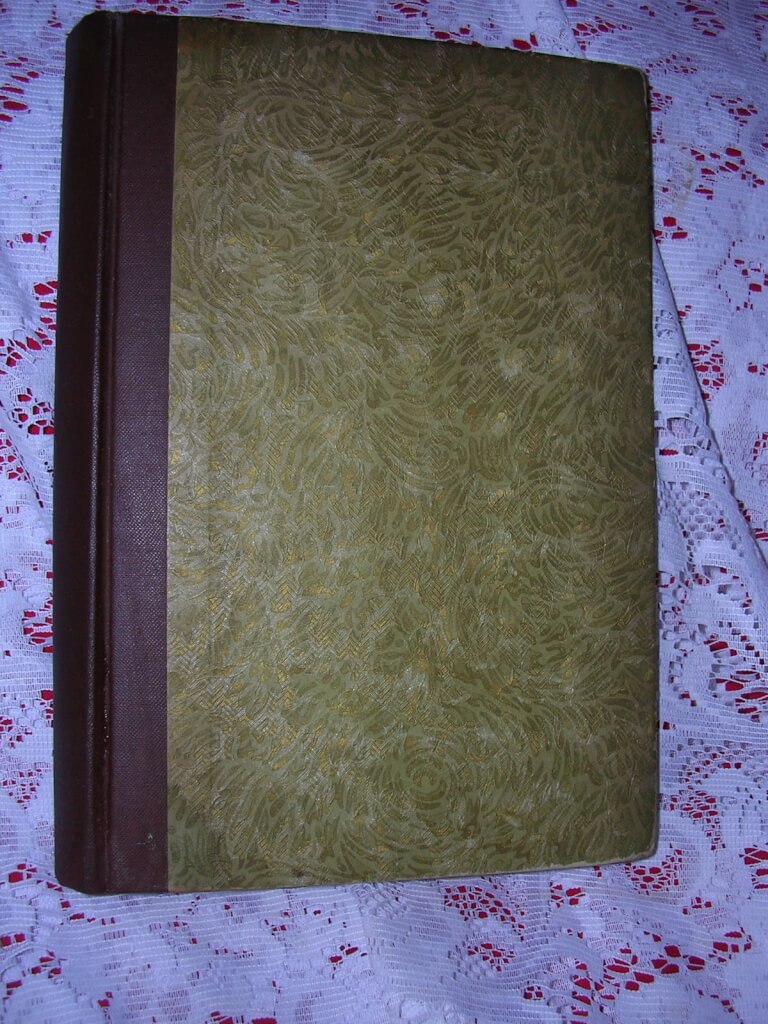 The Satyricon of Petronius Arbiter, Gaius Petronius, trans. ascribed to Oscar Wilde (Privately Printed, 1928, Limited Edition of 1200 unnumberd) 9" X 6 1/4", 236pp, Brown spine with gilt titles (mostly worn off), decorated boards with green and gilt. Deckle bottom and fore edges, top edge inked purple. Fair copy, spine cocked, binding and boards good, corners worn. Satyricon (or Satyrica) is a Latin work of fiction in a mixture of prose and poetry (prosimetrum). It is believed to have been written by Gaius Petronius, though the manuscript tradition identifies the author as a certain Titus Petronius. Classical scholars often describe it as a "Roman novel", without necessarily implying continuity with the modern literary form. The surviving portions of the text detail the misadventures of the narrator, Encolpius, and his lover, a handsome sixteen-year-old boy named Giton. Throughout the novel, Encolpius has a hard time keeping his lover faithful to him as he is constantly being enticed away by others. Encolpius's friend Ascyltus (who seems to have previously been in a relationship with Encolpius) is another major character. It is a rare example of a Roman novel, the only other surviving example (quite different in style and plot) being Metamorphoses of Apuleius. It is also extremely important evidence for the reconstruction of what everyday life must have been like for the lower classes during the early Roman Empire.
The Satyricon of Petronius Arbiter, Gaius Petronius, trans. ascribed to Oscar Wilde (Privately Printed, 1928, Limited Edition of 1200 unnumberd) 9" X 6 1/4", 236pp, Brown spine with gilt titles (mostly worn off), decorated boards with green and gilt. Deckle bottom and fore edges, top edge inked purple. Fair copy, spine cocked, binding and boards good, corners worn. Satyricon (or Satyrica) is a Latin work of fiction in a mixture of prose and poetry (prosimetrum). It is believed to have been written by Gaius Petronius, though the manuscript tradition identifies the author as a certain Titus Petronius. Classical scholars often describe it as a "Roman novel", without necessarily implying continuity with the modern literary form. The surviving portions of the text detail the misadventures of the narrator, Encolpius, and his lover, a handsome sixteen-year-old boy named Giton. Throughout the novel, Encolpius has a hard time keeping his lover faithful to him as he is constantly being enticed away by others. Encolpius's friend Ascyltus (who seems to have previously been in a relationship with Encolpius) is another major character. It is a rare example of a Roman novel, the only other surviving example (quite different in style and plot) being Metamorphoses of Apuleius. It is also extremely important evidence for the reconstruction of what everyday life must have been like for the lower classes during the early Roman Empire. -
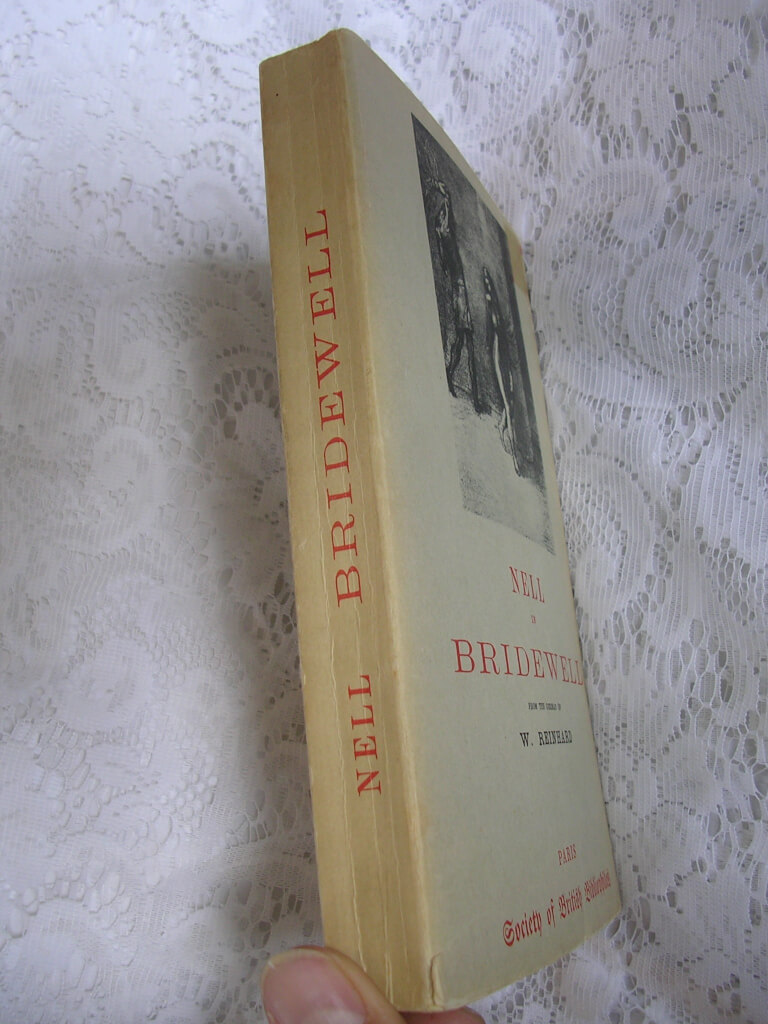
 Nell in Bridewell (Lenchen im Zuchthause), W. Reinhard, trans. W.C. Costello Ph. D. and A. R. Allinson M. A. (Society of British Bibliophiles, Paris, 1900) 8" X 5", 326pp, paperback, good condition, price tag mark on front cover, a tear and some bumping, spine is creased, binding is still good Subtitle: "Description of the System of Corporal Punishment (Flagellation) in the Female Prisons of South Germany up to the year 1848; a contribution to the history of manners." Although the title suggests that this is a "study", it goes beyond the facts and delves into the minds of those who are doing the punishing and those who are being humiliated and punished. Publishers of these "flagellation novels" would often lesson their liability by representing their books as academic studies. Often they would go unnoticed by the larger community unaware of the erotic nature of such a book to a certain segment of the public. In this book, Nell describes in graphic terms the merciless floggings she witnessed of girls and young women, as well as of boys and men and confesses to disturbingly confusing emotions that such sights occasioned in her. She recalls the lustful expressions on the faces of the onlookers, records the fervent words of gratitude to the skillful flogger from the lips of grand ladies who "were only too delighted to see such girls whipped", and tells of the evidently sensual appetites such cruelties incited in the torturers.
Nell in Bridewell (Lenchen im Zuchthause), W. Reinhard, trans. W.C. Costello Ph. D. and A. R. Allinson M. A. (Society of British Bibliophiles, Paris, 1900) 8" X 5", 326pp, paperback, good condition, price tag mark on front cover, a tear and some bumping, spine is creased, binding is still good Subtitle: "Description of the System of Corporal Punishment (Flagellation) in the Female Prisons of South Germany up to the year 1848; a contribution to the history of manners." Although the title suggests that this is a "study", it goes beyond the facts and delves into the minds of those who are doing the punishing and those who are being humiliated and punished. Publishers of these "flagellation novels" would often lesson their liability by representing their books as academic studies. Often they would go unnoticed by the larger community unaware of the erotic nature of such a book to a certain segment of the public. In this book, Nell describes in graphic terms the merciless floggings she witnessed of girls and young women, as well as of boys and men and confesses to disturbingly confusing emotions that such sights occasioned in her. She recalls the lustful expressions on the faces of the onlookers, records the fervent words of gratitude to the skillful flogger from the lips of grand ladies who "were only too delighted to see such girls whipped", and tells of the evidently sensual appetites such cruelties incited in the torturers. -
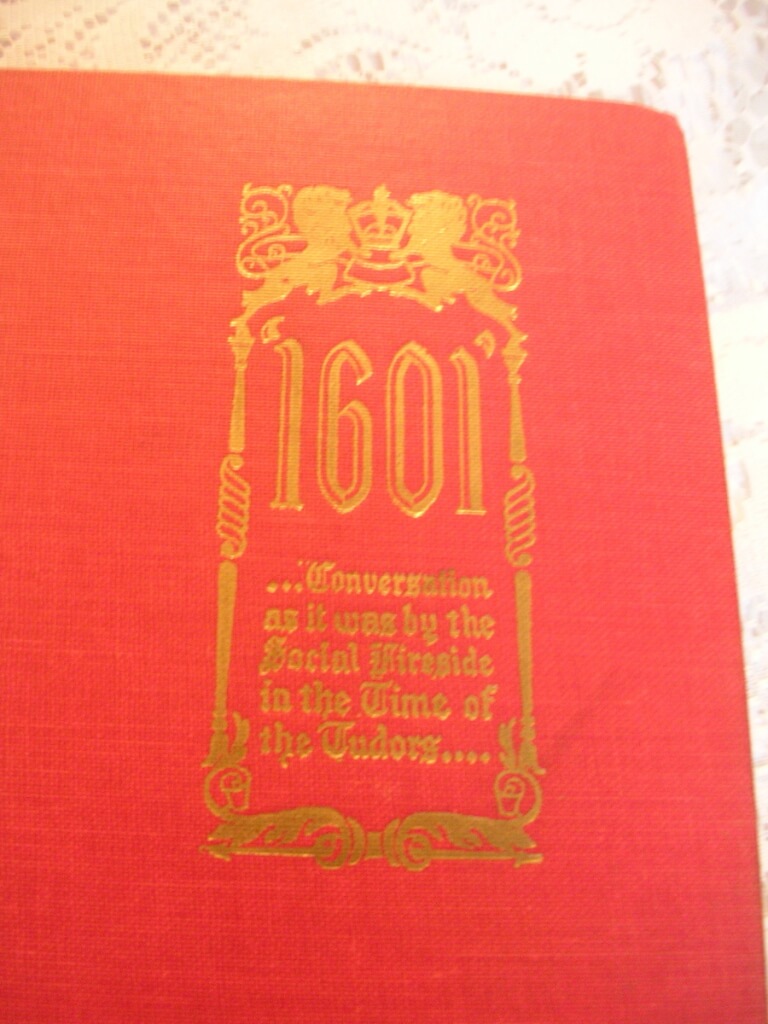
 Mark Twain's [Date, 1601.] Conversation As it was by the Social Fireside in the Time of the Tudors, Mark Twain, "With an Illuminating Introduction, Facetions Footnotes and a Bibliography by Franklin J. Meine" (Privately Printed for Lyle Stuart, New York, nd [c. 1939]) 9 1/2" X 6 1/4", 80pp, hardbound no DJ with slipcase, red cloth boards with gilt lettering and decoration, book very good condition, slight soiling on spine, slipcover good condition, faded spine and soiled but intact [Date: 1601.] Conversation, as it was the Social Fireside, in the Time of the Tudors is the title of a humorous work by Mark Twain, first published anonymously in 1880. Edward Wagenknecht once referred to it as "the most famous piece of pornography in American literature." Its content is irreverent and vulgar rather than obscene, and its purpose seems to be comedic shock rather than erotic arousal. It would thus qualify as ribaldry rather than pornography. Twain wrote 1601 during the summer of 1876 (between writing Tom Sawyer and Huckleberry Finn), for the amusement of his closest friend, Reverend Joseph Twichell, 1601 was later first published by another friend, John Hay, who later became Secretary of State. The work circulated among printers (due to it's often archaic type font) and many small batches were printed, however the authorship of the work remained unverified until Twain finally acknowledged he wrote it in 1906.
Mark Twain's [Date, 1601.] Conversation As it was by the Social Fireside in the Time of the Tudors, Mark Twain, "With an Illuminating Introduction, Facetions Footnotes and a Bibliography by Franklin J. Meine" (Privately Printed for Lyle Stuart, New York, nd [c. 1939]) 9 1/2" X 6 1/4", 80pp, hardbound no DJ with slipcase, red cloth boards with gilt lettering and decoration, book very good condition, slight soiling on spine, slipcover good condition, faded spine and soiled but intact [Date: 1601.] Conversation, as it was the Social Fireside, in the Time of the Tudors is the title of a humorous work by Mark Twain, first published anonymously in 1880. Edward Wagenknecht once referred to it as "the most famous piece of pornography in American literature." Its content is irreverent and vulgar rather than obscene, and its purpose seems to be comedic shock rather than erotic arousal. It would thus qualify as ribaldry rather than pornography. Twain wrote 1601 during the summer of 1876 (between writing Tom Sawyer and Huckleberry Finn), for the amusement of his closest friend, Reverend Joseph Twichell, 1601 was later first published by another friend, John Hay, who later became Secretary of State. The work circulated among printers (due to it's often archaic type font) and many small batches were printed, however the authorship of the work remained unverified until Twain finally acknowledged he wrote it in 1906. -
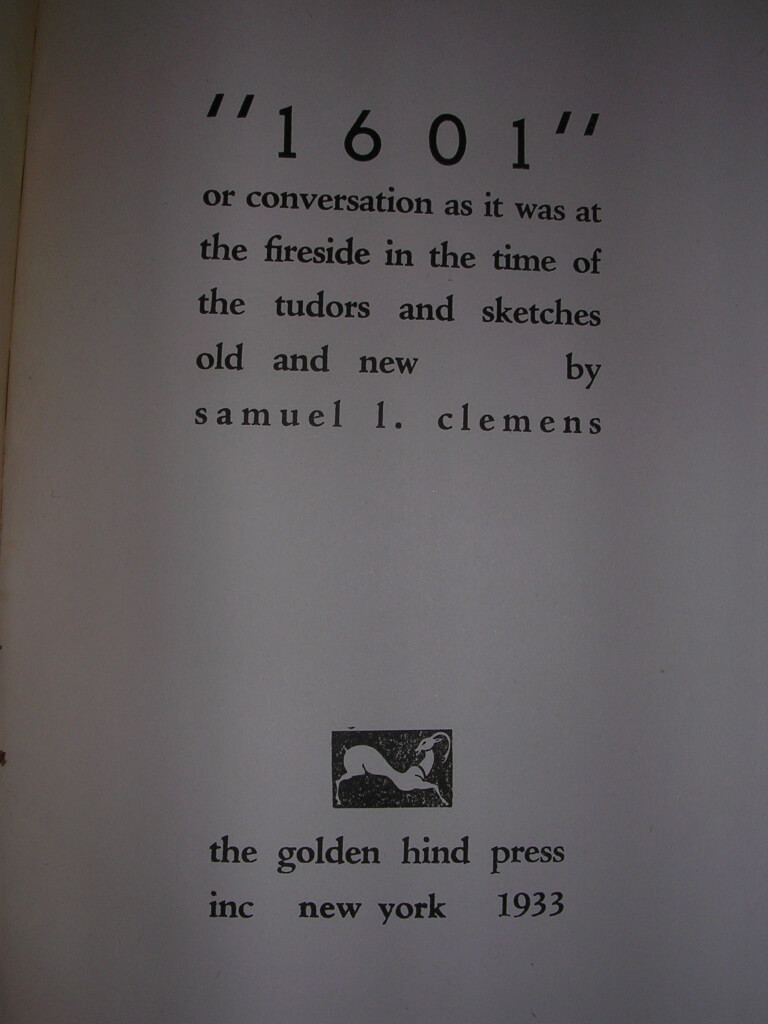
 "1601" or conversation as it was at the fireside in the time of the tudors and sketches old and new by Samuel L. Clemens, Mark Twain, Preface by Samuel Roth (The Golden Hind Press Inc., New York, 1933) 9 1/8" X 6 1/8", 204pp, hardbound no DJ, red cloth boards with gilt decorations and title, fair condition, boards detaching, binding intact, fading on boards and spine [Date: 1601.] Conversation, as it was the Social Fireside, in the Time of the Tudors is the title of a humorous work by Mark Twain, first published anonymously in 1880. Edward Wagenknecht once referred to it as "the most famous piece of pornography in American literature." Its content is irreverent and vulgar rather than obscene, and its purpose seems to be comedic shock rather than erotic arousal. It would thus qualify as ribaldry rather than pornography. Twain wrote 1601 during the summer of 1876 (between writing Tom Sawyer and Huckleberry Finn), for the amusement of his closest friend, Reverend Joseph Twichell, 1601 was later first published by another friend, John Hay, who later became Secretary of State. The work circulated among printers (due to it's often archaic type font) and many small batches were printed, however the authorship of the work remained unverified until Twain finally acknowledged he wrote it in 1906. This book contains 1601 and numerous sketches previously published as "Sketches Old and New"
"1601" or conversation as it was at the fireside in the time of the tudors and sketches old and new by Samuel L. Clemens, Mark Twain, Preface by Samuel Roth (The Golden Hind Press Inc., New York, 1933) 9 1/8" X 6 1/8", 204pp, hardbound no DJ, red cloth boards with gilt decorations and title, fair condition, boards detaching, binding intact, fading on boards and spine [Date: 1601.] Conversation, as it was the Social Fireside, in the Time of the Tudors is the title of a humorous work by Mark Twain, first published anonymously in 1880. Edward Wagenknecht once referred to it as "the most famous piece of pornography in American literature." Its content is irreverent and vulgar rather than obscene, and its purpose seems to be comedic shock rather than erotic arousal. It would thus qualify as ribaldry rather than pornography. Twain wrote 1601 during the summer of 1876 (between writing Tom Sawyer and Huckleberry Finn), for the amusement of his closest friend, Reverend Joseph Twichell, 1601 was later first published by another friend, John Hay, who later became Secretary of State. The work circulated among printers (due to it's often archaic type font) and many small batches were printed, however the authorship of the work remained unverified until Twain finally acknowledged he wrote it in 1906. This book contains 1601 and numerous sketches previously published as "Sketches Old and New" -
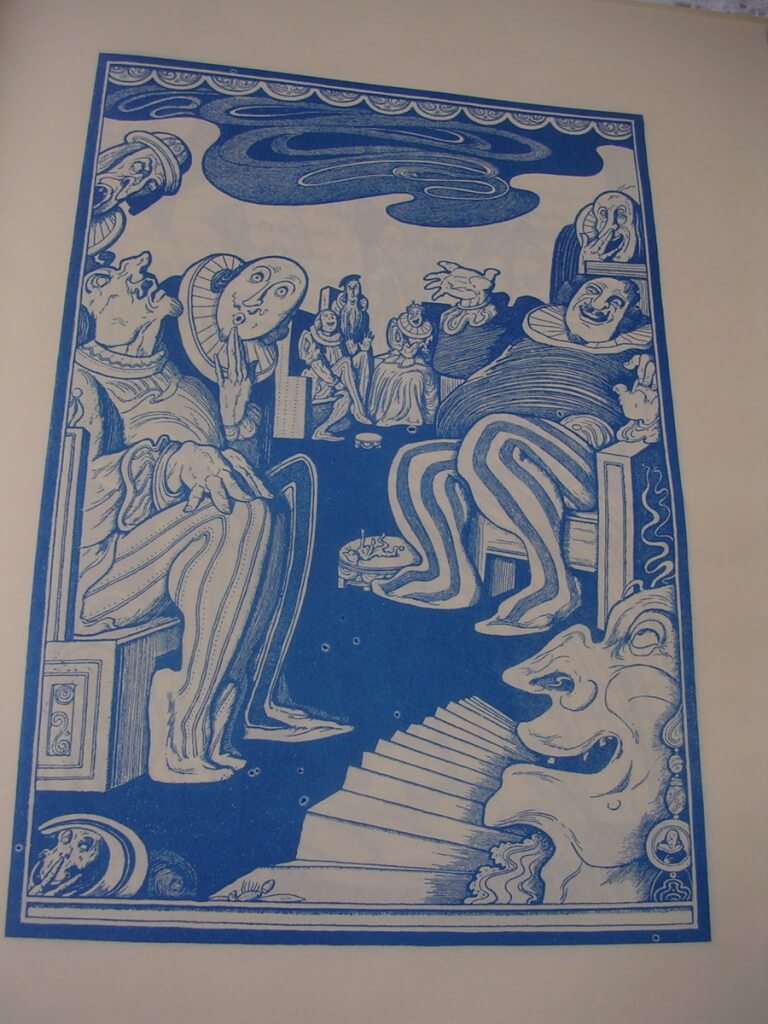
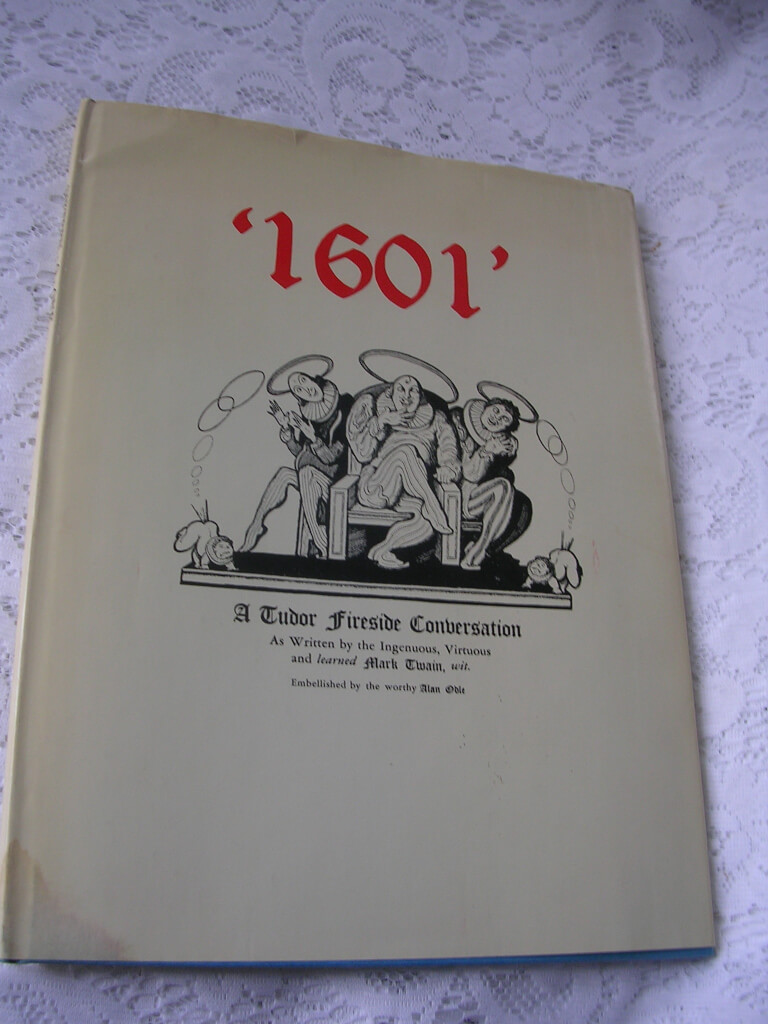 1601 A Tudor Fireside Conversation As Written by the Ingenuous, Virtuous and learned Mark Twain, wit., Embellished by the worthy Alan Odle, Mark Twain, illustrations Alan Odle (Land's End Press, USA, 1969, stated "At London, Printed for Subscribers Only and are to be sold at ye beare Back-Side in Maiden Lane") 12 1/2" X 9 1/2", 24pp (unpaginated), hardbound with dust jacket, blue boards with blue titles, pages, pages printed in such a way that the lower edge is uncut (six folded sheets of paper printed on one side, making up 4 pages) [Date: 1601.] Conversation, as it was the Social Fireside, in the Time of the Tudors is the title of a humorous work by Mark Twain, first published anonymously in 1880. Edward Wagenknecht once referred to it as "the most famous piece of pornography in American literature." Its content is irreverent and vulgar rather than obscene, and its purpose seems to be comedic shock rather than erotic arousal. It would thus qualify as ribaldry rather than pornography. Twain wrote 1601 during the summer of 1876 (between writing Tom Sawyer and Huckleberry Finn), for the amusement of his closest friend, Reverend Joseph Twichell, 1601 was later first published by another friend, John Hay, who later became Secretary of State. The work circulated among printers (due to it's often archaic type font) and many small batches were printed, however the authorship of the work remained unverified until Twain finally acknowledged he wrote it in 1906.
1601 A Tudor Fireside Conversation As Written by the Ingenuous, Virtuous and learned Mark Twain, wit., Embellished by the worthy Alan Odle, Mark Twain, illustrations Alan Odle (Land's End Press, USA, 1969, stated "At London, Printed for Subscribers Only and are to be sold at ye beare Back-Side in Maiden Lane") 12 1/2" X 9 1/2", 24pp (unpaginated), hardbound with dust jacket, blue boards with blue titles, pages, pages printed in such a way that the lower edge is uncut (six folded sheets of paper printed on one side, making up 4 pages) [Date: 1601.] Conversation, as it was the Social Fireside, in the Time of the Tudors is the title of a humorous work by Mark Twain, first published anonymously in 1880. Edward Wagenknecht once referred to it as "the most famous piece of pornography in American literature." Its content is irreverent and vulgar rather than obscene, and its purpose seems to be comedic shock rather than erotic arousal. It would thus qualify as ribaldry rather than pornography. Twain wrote 1601 during the summer of 1876 (between writing Tom Sawyer and Huckleberry Finn), for the amusement of his closest friend, Reverend Joseph Twichell, 1601 was later first published by another friend, John Hay, who later became Secretary of State. The work circulated among printers (due to it's often archaic type font) and many small batches were printed, however the authorship of the work remained unverified until Twain finally acknowledged he wrote it in 1906. -

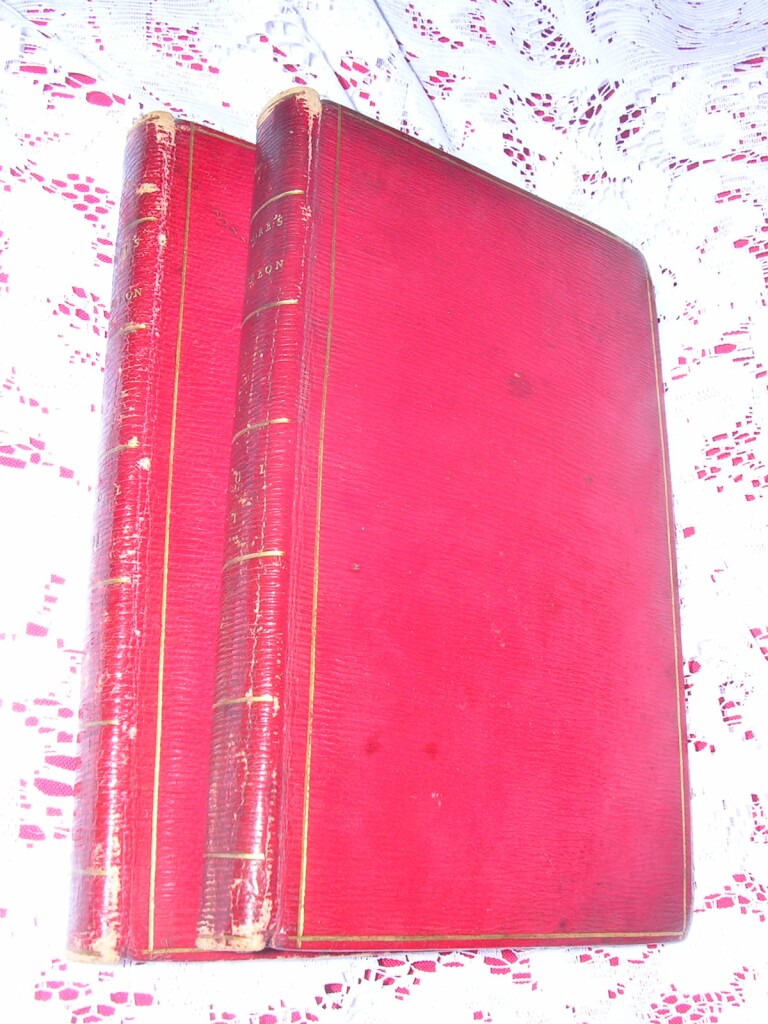 Odes of Anacreon, Anacreon, trans. Thomas Moore (J. and T. Carpenter, London, 1802) 6 1/2" X 4 1/4", 2 vol. 163pp 148pp, hardbound in red morocco with gilt lettering and decorations, gilted edges, marbled boards, worn edges and corners befitting it's age, binding tight, ribbon markers intact. Armorial bookplate of british judge, Geoffrey Lord Cross of Chelsea on front pastedowns Anacreon (582 BC _ 485 BC) was a Greek lyric poet, notable for his drinking songs and hymns. Later Greeks included him in the canonical list of nine lyric poets. Thomas Moore (1779 _ 1852) is considered Ireland's "National Bard". He was a poet, singer, songwriter, and entertainer. He was responsible, with John Murray, for burning Lord Byron's memoirs after his death. These books are the second edition (original edition published in 1800) of his first work, a translation that he did at Middle Temple where he studied law. In his lifetime he was often referred to as Anacreon Moore.
Odes of Anacreon, Anacreon, trans. Thomas Moore (J. and T. Carpenter, London, 1802) 6 1/2" X 4 1/4", 2 vol. 163pp 148pp, hardbound in red morocco with gilt lettering and decorations, gilted edges, marbled boards, worn edges and corners befitting it's age, binding tight, ribbon markers intact. Armorial bookplate of british judge, Geoffrey Lord Cross of Chelsea on front pastedowns Anacreon (582 BC _ 485 BC) was a Greek lyric poet, notable for his drinking songs and hymns. Later Greeks included him in the canonical list of nine lyric poets. Thomas Moore (1779 _ 1852) is considered Ireland's "National Bard". He was a poet, singer, songwriter, and entertainer. He was responsible, with John Murray, for burning Lord Byron's memoirs after his death. These books are the second edition (original edition published in 1800) of his first work, a translation that he did at Middle Temple where he studied law. In his lifetime he was often referred to as Anacreon Moore. -

 My Secret Life, anonymous (Grove Press, Inc., New York, 1966 [first edition thus, first printing]) 9 1/4" X 6 1/4", 2 vol. 1291pp 1069pp [2nd vol. numbered 1291-2359], hardbound with dust jackets (with protector) and slip case, very good condition, very slight sunning on slip case, Ex Libris Robert Kintzler My Secret Life, by "Walter", is the memoir of a Victorian gentleman's sexual development and experiences. Between approximately 1883 and 1895, someone, presumably an Englishman of means, had printed on the Continent an eleven-volume sexual autobiography limited, so he thought, to just six copies. Who the printer or publisher was has not been established with certainty but the most likely possibility is Auguste Brancart, a prolific publisher of erotica who began his career in the early 1880's in Bruxelles and toward the end of the decade moved to Amsterdam. Interestingly, the original title page of My Secret Life has 'Amsterdam. Not for Publication' on it but in the sub rosa world of erotica publishing such indications are to be taken with a pinch of salt. The scarcity of the first edition of My Secret Life has been overstated; it certainly is a rare book. More than six copies, as ordered, were undoubtedly run off. From the number that have reliably been reported to exist, the number appears to have been in the region of twenty to twenty-five sets. Aleister Crowley was supposed to have had one, as well as the silent film comedian Harold Lloyd and Joseph von Sternberg, Marlene Dietrich's director and one-time lover. Charles Reginald Dawes, the last great English collector of erotica, had two sets, one of which was destroyed the the British Customs and the other going eventually to the British Library in 1964. Lord Louis Mountbatten's brother, the 2nd marquess of Milford Haven, certainly possessed a copy for it exists currently in a fine London collection and contains his bookplate. There is a copy in Geneva, another in Hamburg and at least two in New York. Two attempts to publish a reprint in the United States in the 1930's failed due to police action. The first, which began about 1932, followed the original edition as to title and imprint and got as far as volume three before the project was shut down. A copy with 100 original water colors by Clara Tice was auctioned by Parke-Bernet at New York in 1971. A second attempt took place about two years later, with a single volume called Marital Frolics (London [New York or Philadelphia]: For Distribution by Subscription Only [c. 1934]). This constituted an abridgment of volume 5, and was illustrated with ten plates by 'Malay.' A copy was likewise auctioned by Parke-Bernet in the same sale. The Grove Press reprint of 1966 is the first complete edition to be openly available. It was prepared from an eleven-volume typescript made directly from the copy in Hamburg referred to above. All subsequent reprints stem, legally or otherwise, from this. Gershon Legman's Introduction to the Grove Press reprint is a mine of fascinating information, and includes a closely argued case for My Secret Life having been written by Henry Spencer Ashbee, the famous Victorian bibliographer and collector of erotica. The present compiler is unable to share this view, but thinks it likely that Ashbee was involved in seeing it through the press on behalf of somebody else. This book is often wrongly attributed to Frank Harris, through confusion with My Life and Loves, which is a similar (although not as explicit) account of Harris' life. A number of reprints followed the Grove Press edition, including one published by Brandon House of North Hollywood and Pendulum Books of Atlanta, Georgia and a complete French translation.
My Secret Life, anonymous (Grove Press, Inc., New York, 1966 [first edition thus, first printing]) 9 1/4" X 6 1/4", 2 vol. 1291pp 1069pp [2nd vol. numbered 1291-2359], hardbound with dust jackets (with protector) and slip case, very good condition, very slight sunning on slip case, Ex Libris Robert Kintzler My Secret Life, by "Walter", is the memoir of a Victorian gentleman's sexual development and experiences. Between approximately 1883 and 1895, someone, presumably an Englishman of means, had printed on the Continent an eleven-volume sexual autobiography limited, so he thought, to just six copies. Who the printer or publisher was has not been established with certainty but the most likely possibility is Auguste Brancart, a prolific publisher of erotica who began his career in the early 1880's in Bruxelles and toward the end of the decade moved to Amsterdam. Interestingly, the original title page of My Secret Life has 'Amsterdam. Not for Publication' on it but in the sub rosa world of erotica publishing such indications are to be taken with a pinch of salt. The scarcity of the first edition of My Secret Life has been overstated; it certainly is a rare book. More than six copies, as ordered, were undoubtedly run off. From the number that have reliably been reported to exist, the number appears to have been in the region of twenty to twenty-five sets. Aleister Crowley was supposed to have had one, as well as the silent film comedian Harold Lloyd and Joseph von Sternberg, Marlene Dietrich's director and one-time lover. Charles Reginald Dawes, the last great English collector of erotica, had two sets, one of which was destroyed the the British Customs and the other going eventually to the British Library in 1964. Lord Louis Mountbatten's brother, the 2nd marquess of Milford Haven, certainly possessed a copy for it exists currently in a fine London collection and contains his bookplate. There is a copy in Geneva, another in Hamburg and at least two in New York. Two attempts to publish a reprint in the United States in the 1930's failed due to police action. The first, which began about 1932, followed the original edition as to title and imprint and got as far as volume three before the project was shut down. A copy with 100 original water colors by Clara Tice was auctioned by Parke-Bernet at New York in 1971. A second attempt took place about two years later, with a single volume called Marital Frolics (London [New York or Philadelphia]: For Distribution by Subscription Only [c. 1934]). This constituted an abridgment of volume 5, and was illustrated with ten plates by 'Malay.' A copy was likewise auctioned by Parke-Bernet in the same sale. The Grove Press reprint of 1966 is the first complete edition to be openly available. It was prepared from an eleven-volume typescript made directly from the copy in Hamburg referred to above. All subsequent reprints stem, legally or otherwise, from this. Gershon Legman's Introduction to the Grove Press reprint is a mine of fascinating information, and includes a closely argued case for My Secret Life having been written by Henry Spencer Ashbee, the famous Victorian bibliographer and collector of erotica. The present compiler is unable to share this view, but thinks it likely that Ashbee was involved in seeing it through the press on behalf of somebody else. This book is often wrongly attributed to Frank Harris, through confusion with My Life and Loves, which is a similar (although not as explicit) account of Harris' life. A number of reprints followed the Grove Press edition, including one published by Brandon House of North Hollywood and Pendulum Books of Atlanta, Georgia and a complete French translation. -
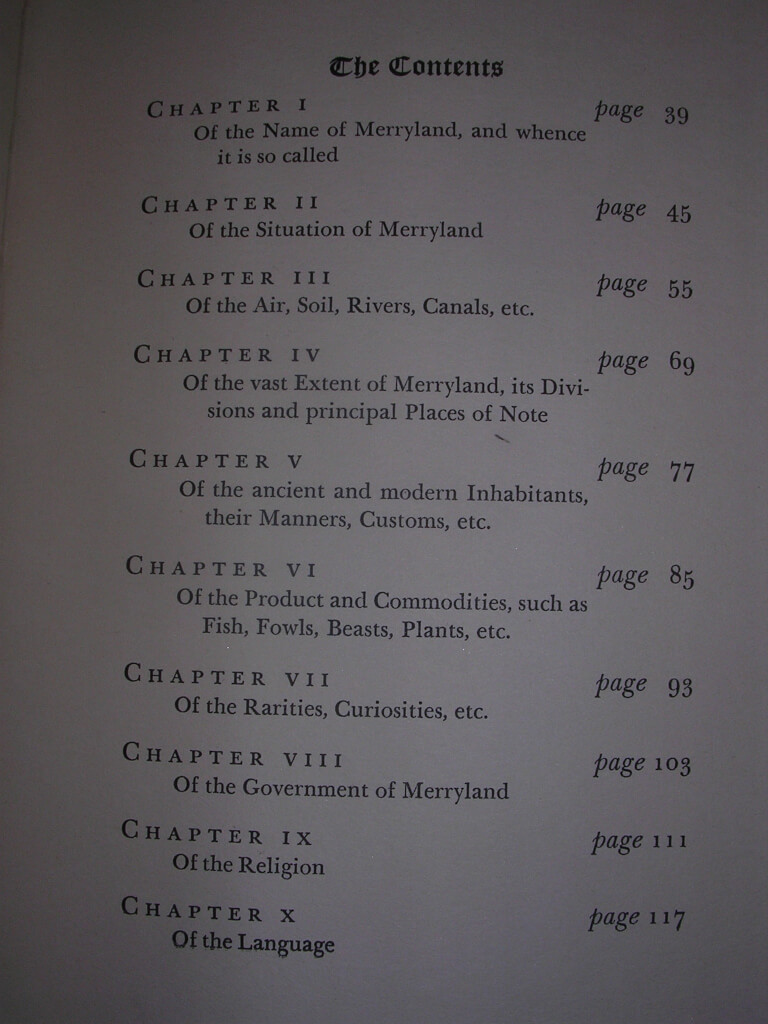
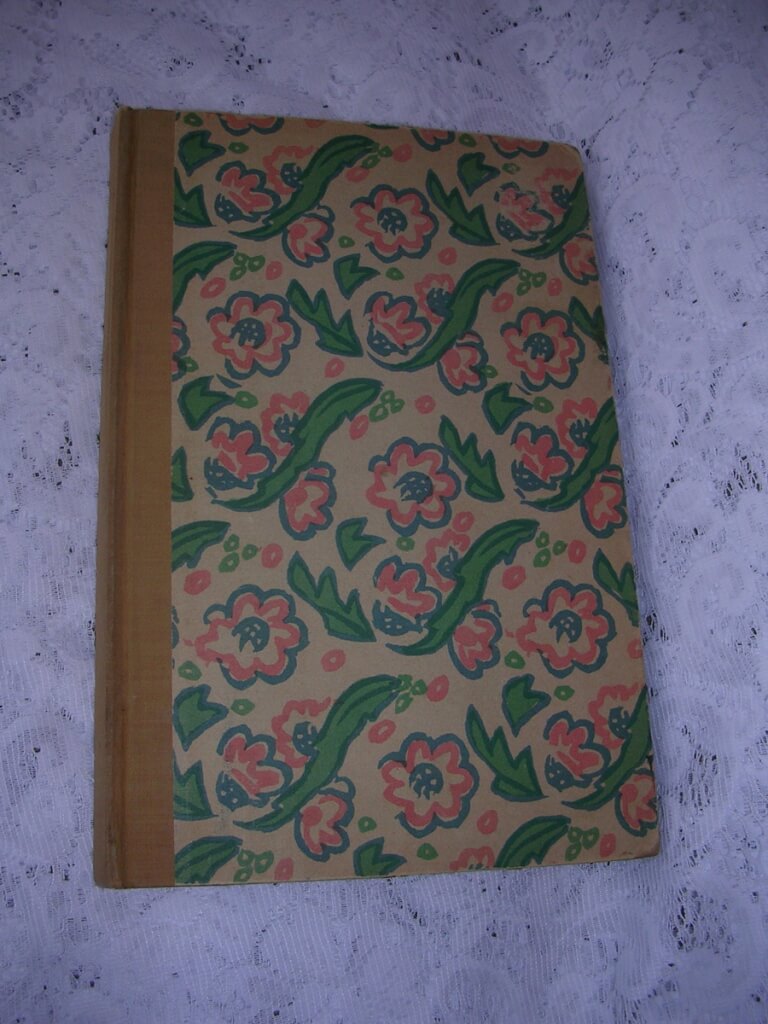 Merryland, Thomas Stretzer (Privately Issued, New York, Robin Hood House, 1932) 9 3/8" X 6 1/4", 136pp, hardbound no DJ, decorative paper boards with mylar protector, flower design, gilt lettering on spine, very good condition The Merryland books were a somewhat peculiar genre of English seventeenth and eighteenth century erotic fiction in which the female body was described in terms of a topographical metaphor derived from a pun on Maryland. Stretzer's book is typical of the genre in depicting the female body as a landscape that men explore, till, and plow. For example, he writes: "Her valleys are like Eden, her hills like Lebanon, she is a paradise of pleasure and a garden of delight."
Merryland, Thomas Stretzer (Privately Issued, New York, Robin Hood House, 1932) 9 3/8" X 6 1/4", 136pp, hardbound no DJ, decorative paper boards with mylar protector, flower design, gilt lettering on spine, very good condition The Merryland books were a somewhat peculiar genre of English seventeenth and eighteenth century erotic fiction in which the female body was described in terms of a topographical metaphor derived from a pun on Maryland. Stretzer's book is typical of the genre in depicting the female body as a landscape that men explore, till, and plow. For example, he writes: "Her valleys are like Eden, her hills like Lebanon, she is a paradise of pleasure and a garden of delight." -
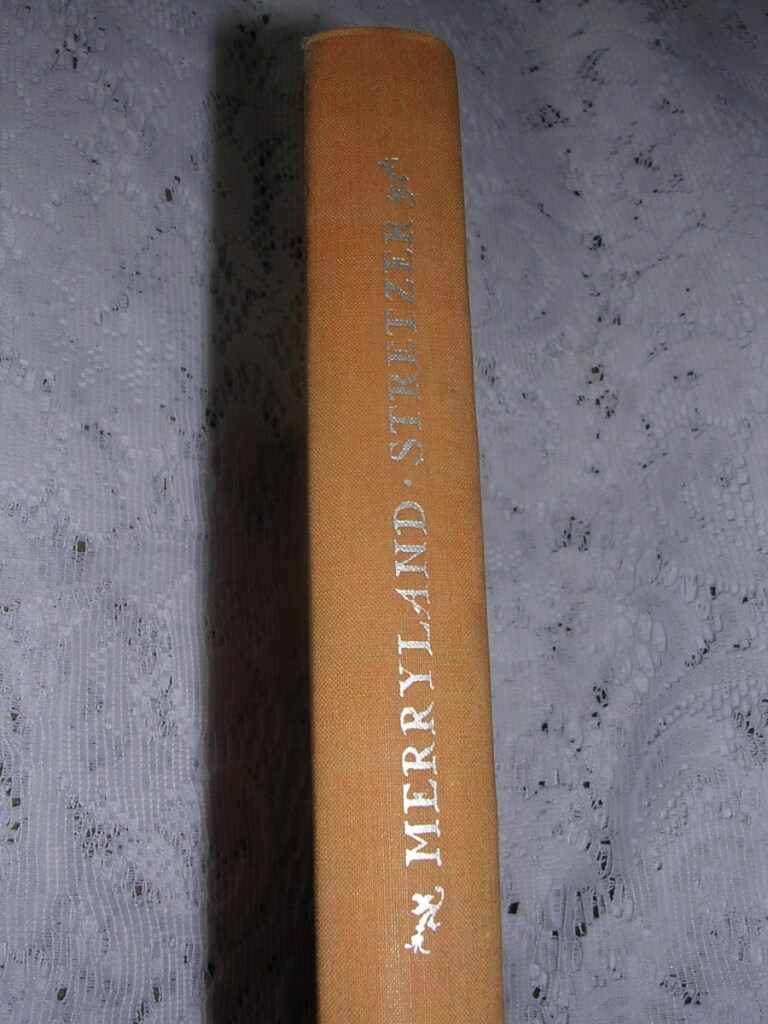
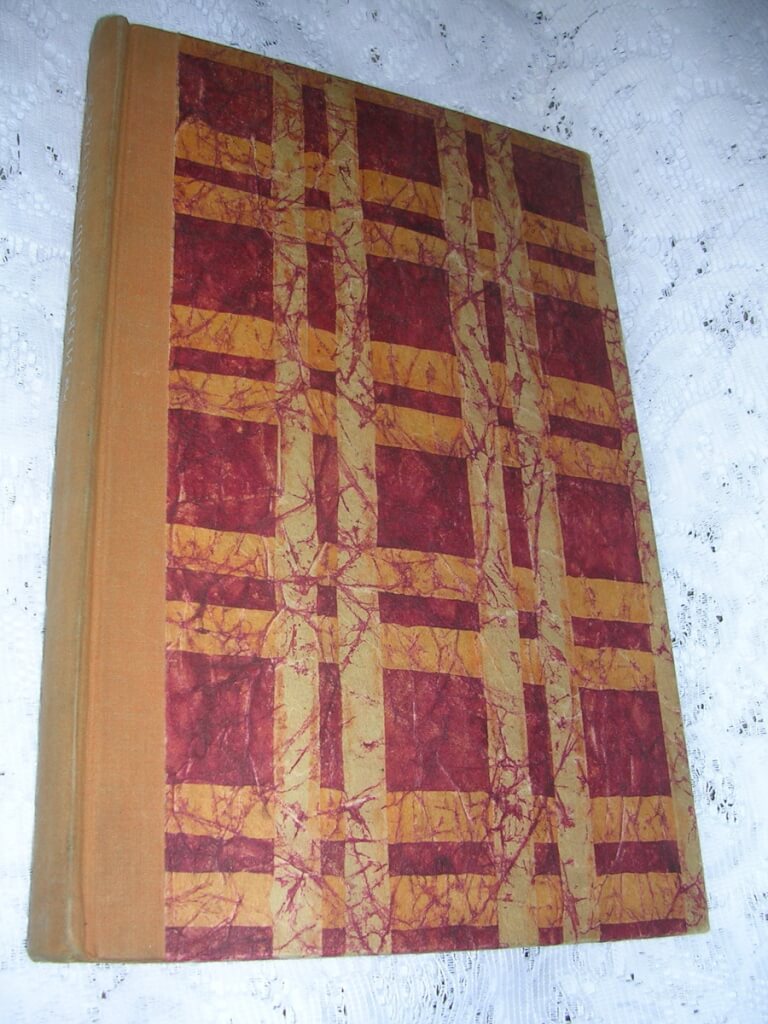 Merryland, Thomas Stretzer (Privately Issued, New York, Robin Hood House, 1932) 9 3/8" X 6 1/8", 136pp, hardbound no DJ, decorative paper boards, silver gilt lettering on spine, very good condition The Merryland books were a somewhat peculiar genre of English seventeenth and eighteenth century erotic fiction in which the female body was described in terms of a topographical metaphor derived from a pun on Maryland. Stretzer's book is typical of the genre in depicting the female body as a landscape that men explore, till, and plow. For example, he writes: "Her valleys are like Eden, her hills like Lebanon, she is a paradise of pleasure and a garden of delight."
Merryland, Thomas Stretzer (Privately Issued, New York, Robin Hood House, 1932) 9 3/8" X 6 1/8", 136pp, hardbound no DJ, decorative paper boards, silver gilt lettering on spine, very good condition The Merryland books were a somewhat peculiar genre of English seventeenth and eighteenth century erotic fiction in which the female body was described in terms of a topographical metaphor derived from a pun on Maryland. Stretzer's book is typical of the genre in depicting the female body as a landscape that men explore, till, and plow. For example, he writes: "Her valleys are like Eden, her hills like Lebanon, she is a paradise of pleasure and a garden of delight." -

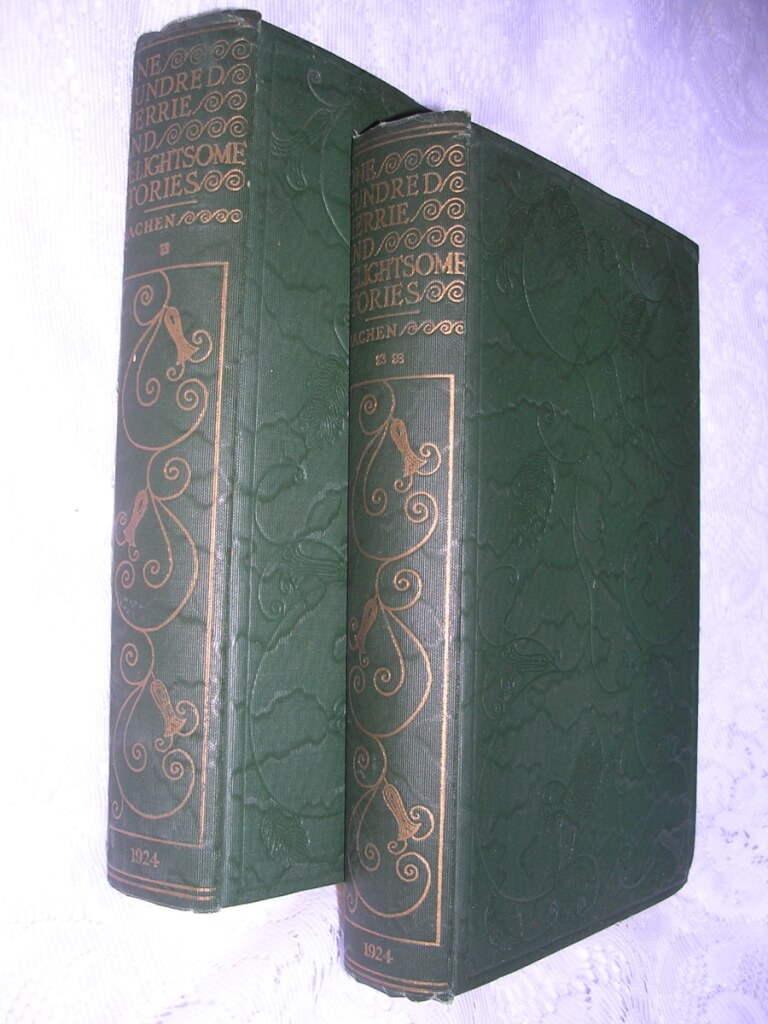 One Hundred Merrie and Delightsome Stories (Les Cent Nouvelles Nouvelles) (2 volumes), trans. Robert B. Douglas (Privately Printed for Subscribers only, Carbonnek, 1924, #591/1250) 8 7/8" X 5 3/4", 2 vol. 279pp 272pp, hardbound no DJ, dark green moire silk boards decorated in blind stamp, spines lettered and decorated in gilt, gilt top edge, other edges deckle, frontispiece signed by the artist, Clara Tice, very good condition, slight bumping on corners This is a two volume set of books beautifully bound and in excellent condition. Some pages remain uncut. A rare book in rare condition. It is signed by the artist, Clara Tice, under the frontispiece. It is illustrated with 16 full page drawings by Clara Tice. Purported a collection of short stories narrated by various persons at the court of Philippe le Bon, and collected together by Antoine de la Sale, the nouvelles are, according to the authority on French Literature—Professor George Saintsbury "undoubtedly the first work of literary prose in French ... The short prose tale of a comic character is the one French literary product the pre-eminence and perfection of which it is impossible to dispute, and the prose tale first appears to advantage in the Cent Nouvelles Nouvelles." The stories give a curious glimpses of life in the 15th century, providing a genuine view of the social condition of the nobility and the middle classes. M. Lenient, a French critic, says: "Generally the incidents and personages belong to the bourgeoisée; there is nothing chivalric, nothing wonderful; no dreamy lovers, romantic dames, fairies, or enchanters. Noble dames, bourgeois, nuns, knights, merchants, monks, and peasants mutually dupe each other. The lord deceives the miller's wife by imposing on her simplicity, and the miller retaliates in much the same manner. The shepherd marries the knight's sister, and the nobleman is not over scandalized. The vices of the monks are depicted in half a score tales, and the seducers are punished with a severity not always in proportion to the offence." For four centuries 10 of the stories were credited to Louis XI. Modern scholars have since ascribed them to either Philippe le Bel or Comte de Charolais. In all, some thirty-two noblemen or squires contributed the stories, with some 14 or 15 taken from Giovanni Boccaccio, and as many more from Gian Francesco Poggio Bracciolini or other Italian writers, or French fabliaux, but about 70 of them appear to be original.
One Hundred Merrie and Delightsome Stories (Les Cent Nouvelles Nouvelles) (2 volumes), trans. Robert B. Douglas (Privately Printed for Subscribers only, Carbonnek, 1924, #591/1250) 8 7/8" X 5 3/4", 2 vol. 279pp 272pp, hardbound no DJ, dark green moire silk boards decorated in blind stamp, spines lettered and decorated in gilt, gilt top edge, other edges deckle, frontispiece signed by the artist, Clara Tice, very good condition, slight bumping on corners This is a two volume set of books beautifully bound and in excellent condition. Some pages remain uncut. A rare book in rare condition. It is signed by the artist, Clara Tice, under the frontispiece. It is illustrated with 16 full page drawings by Clara Tice. Purported a collection of short stories narrated by various persons at the court of Philippe le Bon, and collected together by Antoine de la Sale, the nouvelles are, according to the authority on French Literature—Professor George Saintsbury "undoubtedly the first work of literary prose in French ... The short prose tale of a comic character is the one French literary product the pre-eminence and perfection of which it is impossible to dispute, and the prose tale first appears to advantage in the Cent Nouvelles Nouvelles." The stories give a curious glimpses of life in the 15th century, providing a genuine view of the social condition of the nobility and the middle classes. M. Lenient, a French critic, says: "Generally the incidents and personages belong to the bourgeoisée; there is nothing chivalric, nothing wonderful; no dreamy lovers, romantic dames, fairies, or enchanters. Noble dames, bourgeois, nuns, knights, merchants, monks, and peasants mutually dupe each other. The lord deceives the miller's wife by imposing on her simplicity, and the miller retaliates in much the same manner. The shepherd marries the knight's sister, and the nobleman is not over scandalized. The vices of the monks are depicted in half a score tales, and the seducers are punished with a severity not always in proportion to the offence." For four centuries 10 of the stories were credited to Louis XI. Modern scholars have since ascribed them to either Philippe le Bel or Comte de Charolais. In all, some thirty-two noblemen or squires contributed the stories, with some 14 or 15 taken from Giovanni Boccaccio, and as many more from Gian Francesco Poggio Bracciolini or other Italian writers, or French fabliaux, but about 70 of them appear to be original. -
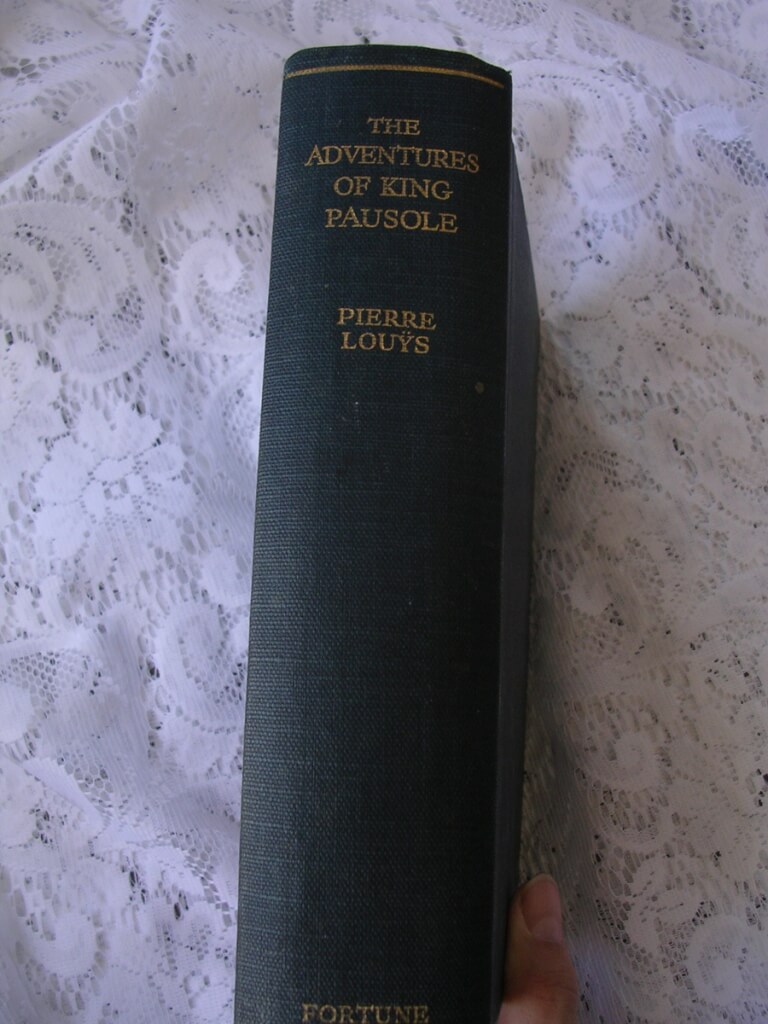
 The Adventures of King Pausole, Pierre Louys, trans. Charles Hope Lumley, illustrated by Beresford Egan (The Fortune Press, London, 1929, #333/1200, "printed at Leige by the Imprimerie Vaillant-Carmanne - M. C. M. XXIX") 9 1/4" X 7", 312pp, hardbound no DJ, quarter cloth, marbled boards, gilt lettering on spine, printed on "batchelor hand-made paper", top edge gilted other edges deckle, in good condition, corners are bumped, some pages remain uncut, spine slightly cocked, some light rubbing to tail some pages remain unread/uncut Pierre Louys (1870 - 1925) was a French poet and writer, most renowned for lesbian and classical themes in some of his writings. He is known as a writer who "expressed pagan sensuality with stylistic perfection." This book is a humorous and risqué "libertine" story about a king with many wives (one for each day of the year). As part of the story, King Pausole had two laws "1. hurt no man. 2. Then do as you please." This law has been embraced many including pagan/wiccan community when Aleister Crowley introduced this as his "First Law". First English edition, 6 full page colour plates by Beresford.
The Adventures of King Pausole, Pierre Louys, trans. Charles Hope Lumley, illustrated by Beresford Egan (The Fortune Press, London, 1929, #333/1200, "printed at Leige by the Imprimerie Vaillant-Carmanne - M. C. M. XXIX") 9 1/4" X 7", 312pp, hardbound no DJ, quarter cloth, marbled boards, gilt lettering on spine, printed on "batchelor hand-made paper", top edge gilted other edges deckle, in good condition, corners are bumped, some pages remain uncut, spine slightly cocked, some light rubbing to tail some pages remain unread/uncut Pierre Louys (1870 - 1925) was a French poet and writer, most renowned for lesbian and classical themes in some of his writings. He is known as a writer who "expressed pagan sensuality with stylistic perfection." This book is a humorous and risqué "libertine" story about a king with many wives (one for each day of the year). As part of the story, King Pausole had two laws "1. hurt no man. 2. Then do as you please." This law has been embraced many including pagan/wiccan community when Aleister Crowley introduced this as his "First Law". First English edition, 6 full page colour plates by Beresford. -
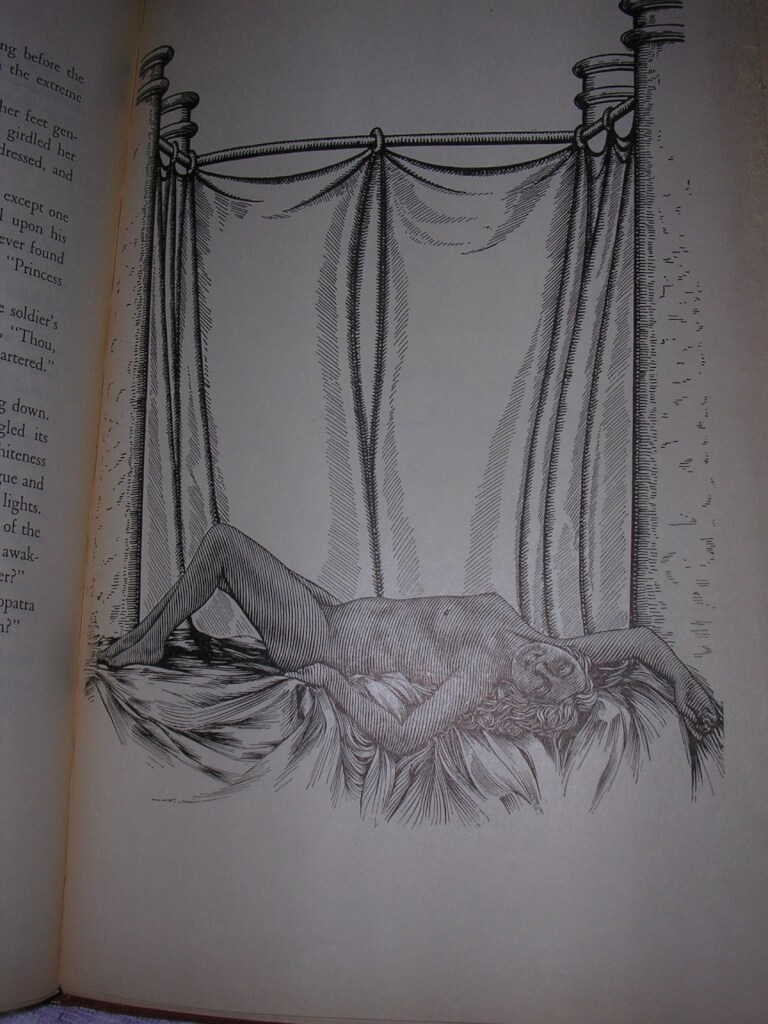
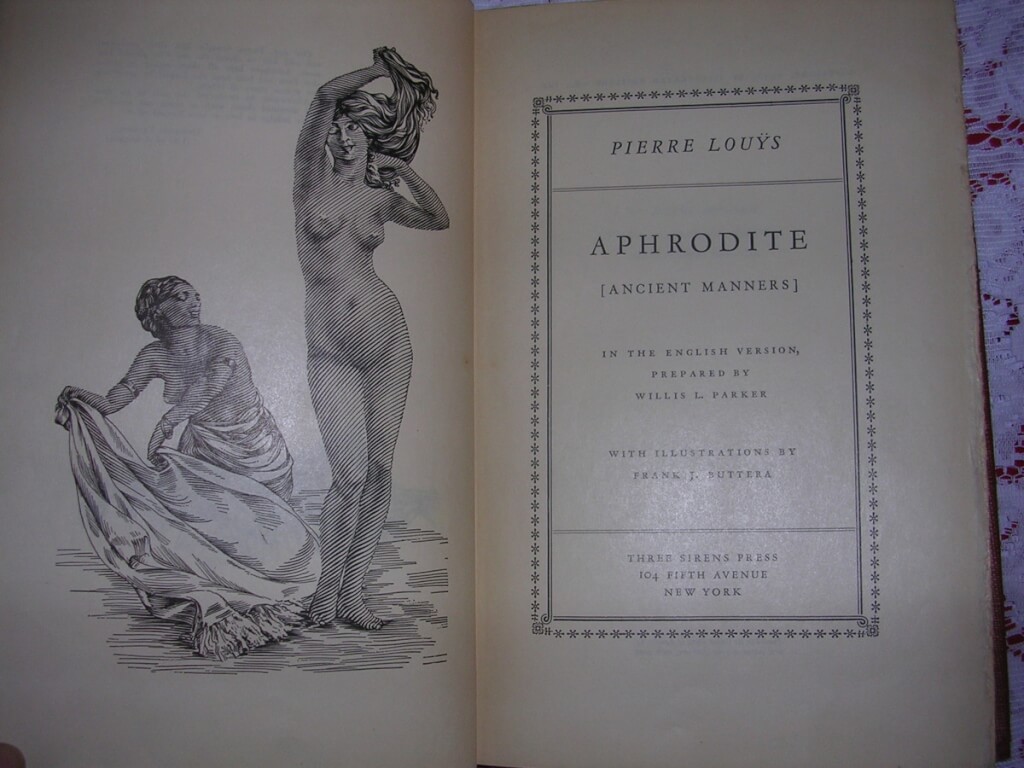 Aphrodite (Ancient Manners), Pierre Louys, trans. Willis L. Parker, illustrator Frank J. Buttera (Three Sirens Press, New York, 1932) 9 1/2" X 6 1/4", 251pp, hardbound no DJ, red cloth over boards with gilt decorations, deckle fore and bottom edge, inked top edge, very good condition, minor bumping to corners Pierre Louys (1870 - 1925) was a French poet and writer, most renowned for lesbian and classical themes in some of his writings. He is known as a writer who "expressed pagan sensuality with stylistic perfection." "Aphrodite: mæurs antiques" (Ancient Manners) is a "libertine" story set in ancient Alexandria. Highlights include the loves of Chrysis, an orgy banquet ending in the crucifixion of a slave, the love of two young musician girls and the festivals of Aphrodite. This edition is illustrated by Frank J. Buttera
Aphrodite (Ancient Manners), Pierre Louys, trans. Willis L. Parker, illustrator Frank J. Buttera (Three Sirens Press, New York, 1932) 9 1/2" X 6 1/4", 251pp, hardbound no DJ, red cloth over boards with gilt decorations, deckle fore and bottom edge, inked top edge, very good condition, minor bumping to corners Pierre Louys (1870 - 1925) was a French poet and writer, most renowned for lesbian and classical themes in some of his writings. He is known as a writer who "expressed pagan sensuality with stylistic perfection." "Aphrodite: mæurs antiques" (Ancient Manners) is a "libertine" story set in ancient Alexandria. Highlights include the loves of Chrysis, an orgy banquet ending in the crucifixion of a slave, the love of two young musician girls and the festivals of Aphrodite. This edition is illustrated by Frank J. Buttera -
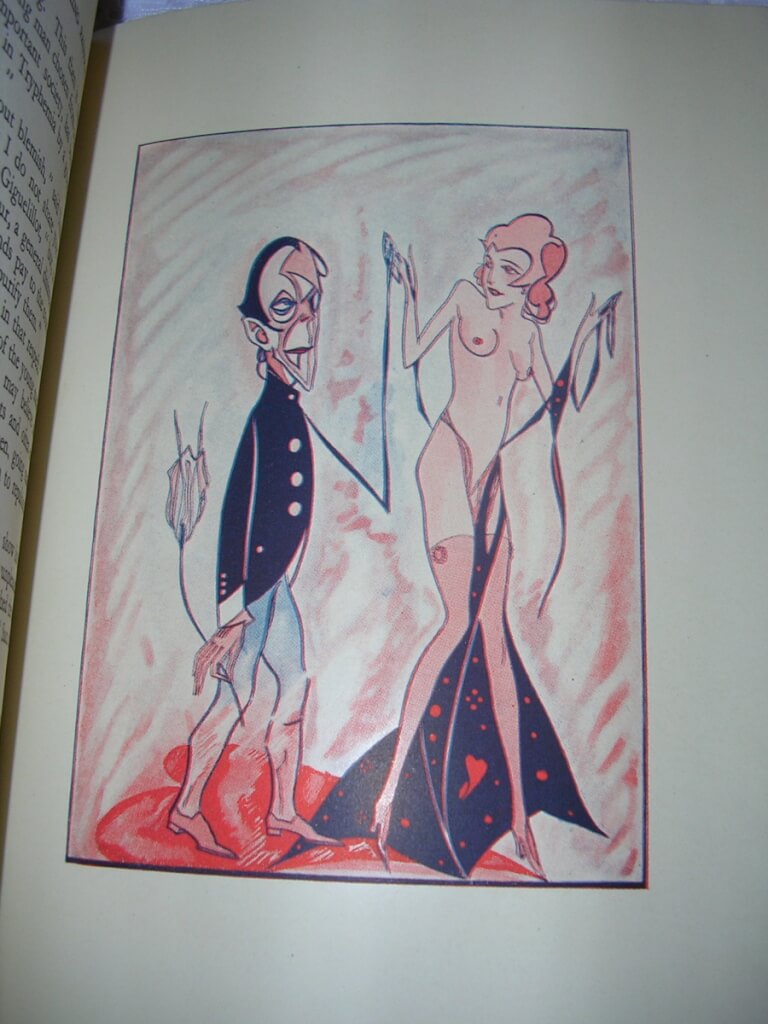
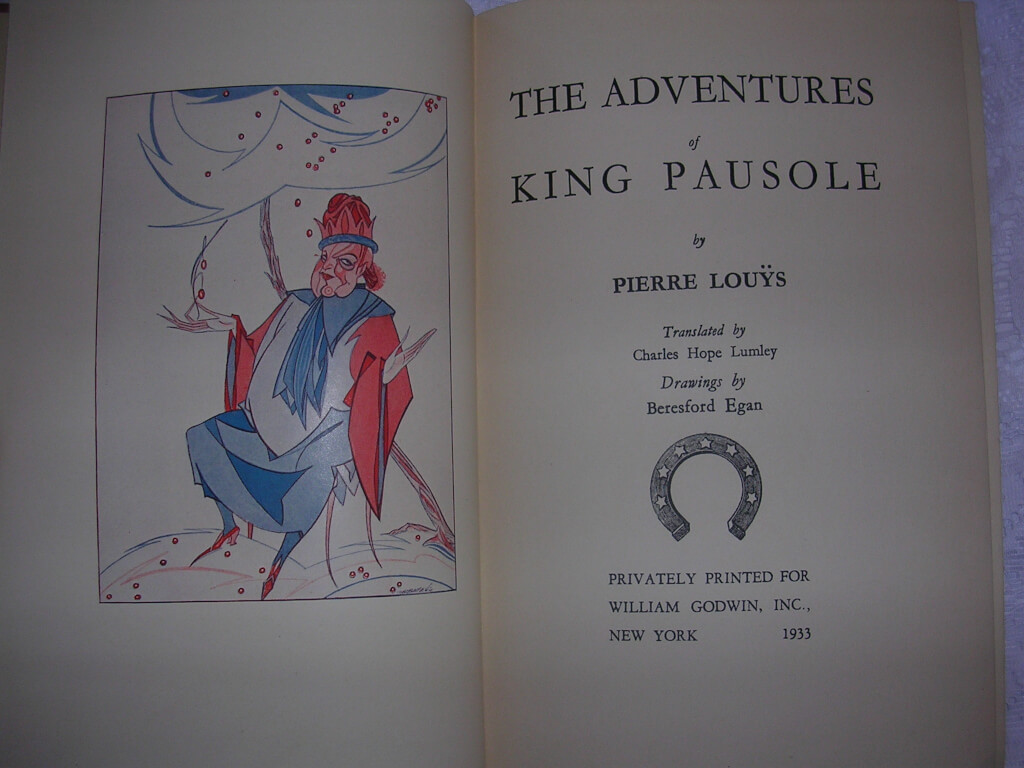 The Adventures of King Pausole, Pierre Louys, trans. Charles Hope Lumley, illustrated by Beresford Egan (Privately Printed for William Godwin, Inc., New York, 1933) 9 1/2" X 6 1/2", 312pp, hardbound no DJ, red cloth with silver gilting on the spine and a nude woman on the cover, good condition, binding strong, some fading on covers and spine. Pierre Louys (1870 - 1925) was a French poet and writer, most renowned for lesbian and classical themes in some of his writings. He is known as a writer who "expressed pagan sensuality with stylistic perfection." This book is a humorous and risqué "libertine" story about a king with many wives (one for each day of the year). As part of the story, King Pausole had two laws "1. hurt no man. 2. Then do as you please."
The Adventures of King Pausole, Pierre Louys, trans. Charles Hope Lumley, illustrated by Beresford Egan (Privately Printed for William Godwin, Inc., New York, 1933) 9 1/2" X 6 1/2", 312pp, hardbound no DJ, red cloth with silver gilting on the spine and a nude woman on the cover, good condition, binding strong, some fading on covers and spine. Pierre Louys (1870 - 1925) was a French poet and writer, most renowned for lesbian and classical themes in some of his writings. He is known as a writer who "expressed pagan sensuality with stylistic perfection." This book is a humorous and risqué "libertine" story about a king with many wives (one for each day of the year). As part of the story, King Pausole had two laws "1. hurt no man. 2. Then do as you please." -
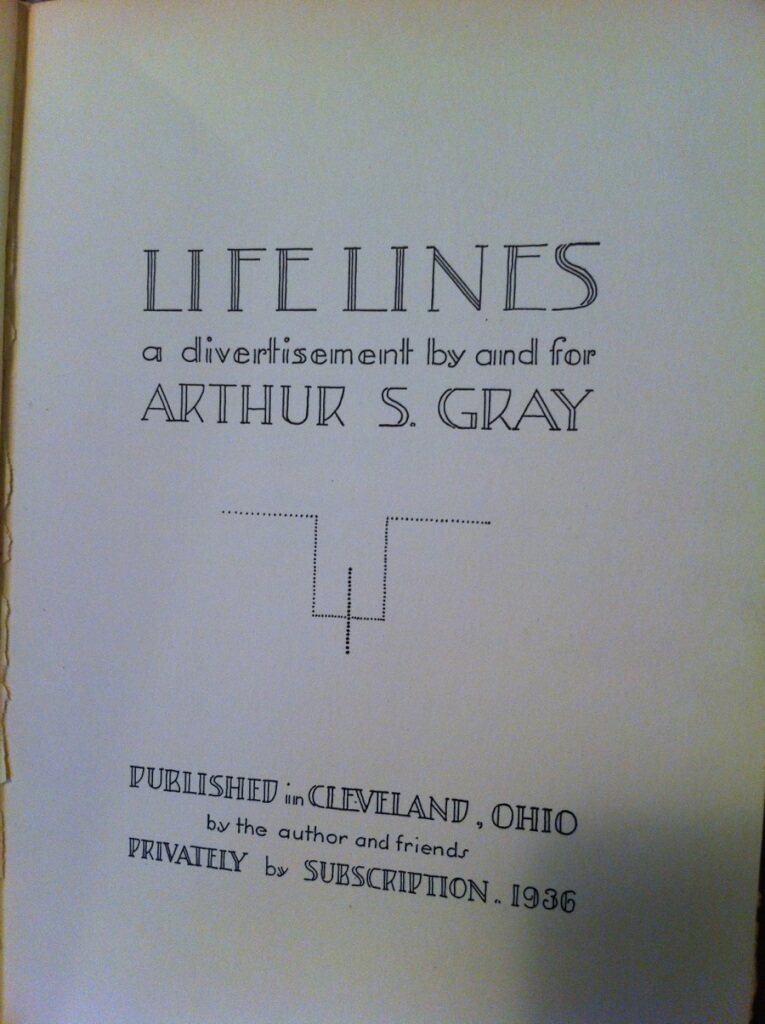
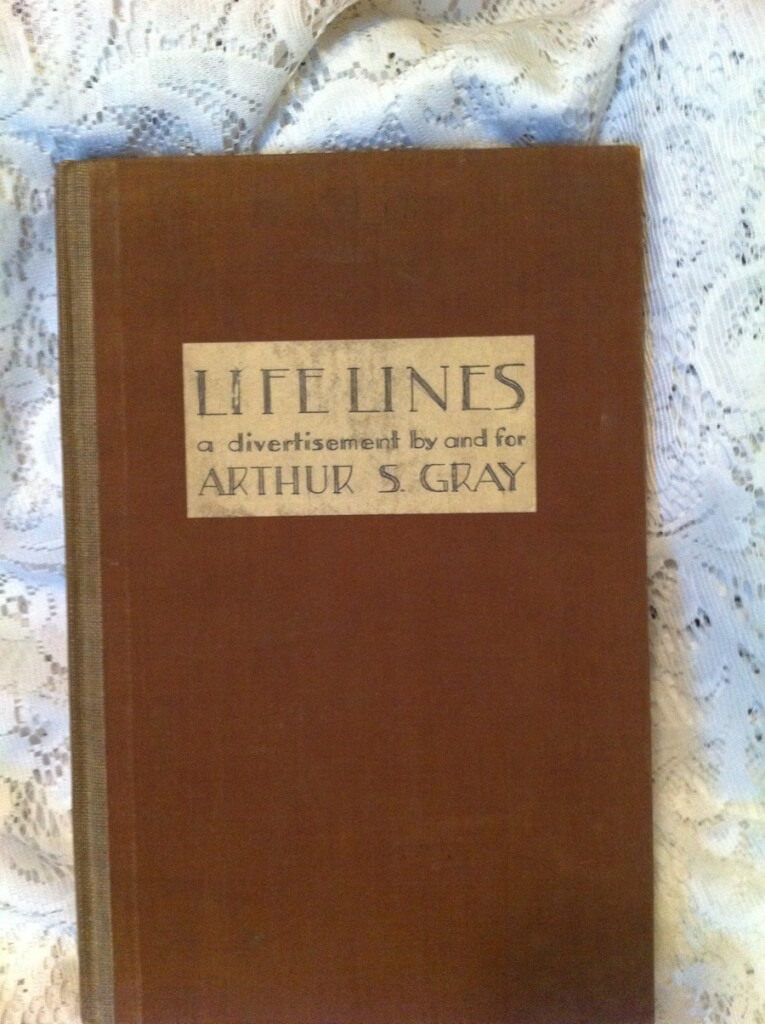 Life Lines, Arthur S. Gray ("Published in Cleveland, Ohio by the author and friends, Privately by Subscription, 1936") 10 1/8 X 6 3/4, 93pp, hardbound no DJ, deckle edges, good condition, slight soiling to boards The title page reads "Life Lines, a divertisement by and for Arthur S. Gray". Published in Cleveland, Ohio by the author and friends, Privately by Subscription, 1936". The author writes in his preface, "Because this book is a Michelangelo collection of poems and drawings done now and then for my diversion and satisfaction, it is necessary to announce that the pictures are not illustrations. Each drawing is a simple record of some particular and more or less unique quality which caught my attention and incited me to draw. After the prime reason, the urge to make something. I draw the way I do for two reasons: first to preserve the integrity of my powers of observation and reaction; second, to render that respect which is the natural right of an individual entity."
Life Lines, Arthur S. Gray ("Published in Cleveland, Ohio by the author and friends, Privately by Subscription, 1936") 10 1/8 X 6 3/4, 93pp, hardbound no DJ, deckle edges, good condition, slight soiling to boards The title page reads "Life Lines, a divertisement by and for Arthur S. Gray". Published in Cleveland, Ohio by the author and friends, Privately by Subscription, 1936". The author writes in his preface, "Because this book is a Michelangelo collection of poems and drawings done now and then for my diversion and satisfaction, it is necessary to announce that the pictures are not illustrations. Each drawing is a simple record of some particular and more or less unique quality which caught my attention and incited me to draw. After the prime reason, the urge to make something. I draw the way I do for two reasons: first to preserve the integrity of my powers of observation and reaction; second, to render that respect which is the natural right of an individual entity." -
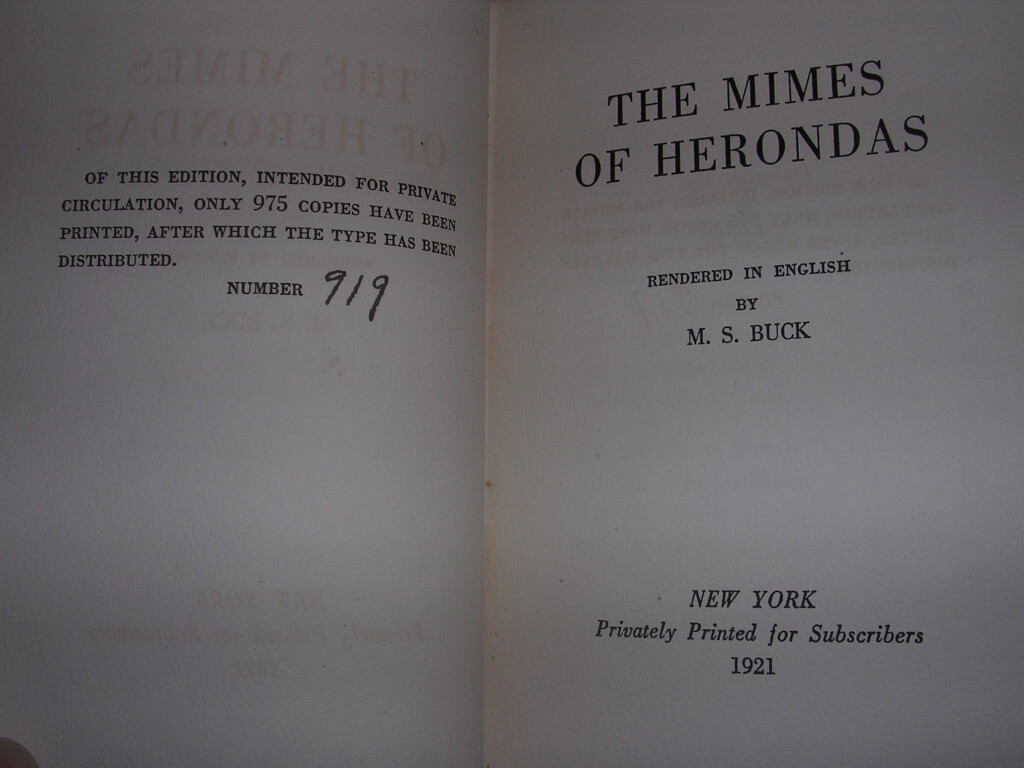
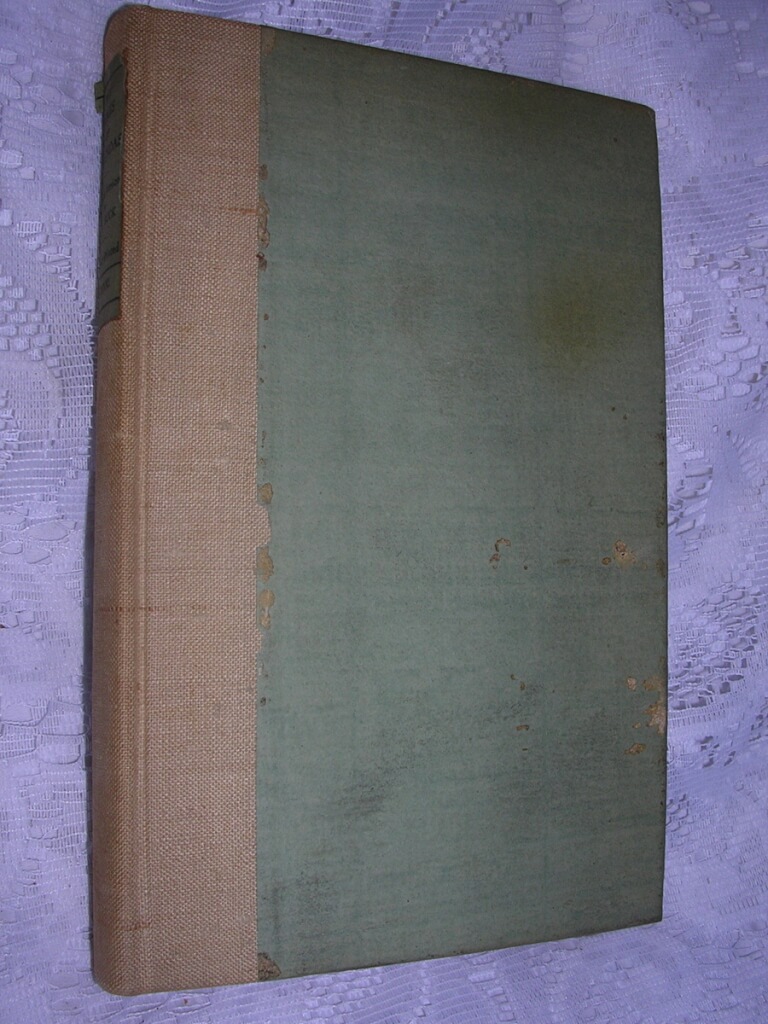 The Mimes of Herondas, trans. M. S. Buck (Privately Printed for Subscribers, New York, 1921, #70/975) 7" X 4 5/8", 119pp, hardbound no DJ, paper boards with beige cloth spine, top edge gilt, others deckle, good condition, lightly soiled Herodas was a Greek poet and the author of short humorous dramatic scenes in verse, written under the Alexandrian empire in the 3rd century BC. Mimes were scenes in popular life in South Italy and Sicily, written in the language of the people, vigorous with racy proverbs such as we get in other reflections of that region. The Mimes of Herodas have been known to us only since the discovery and publication of the "Kenyon", M. S. Buck, by the British Museum in 1891 (from a parchment containing 7 legible mimes half of the 8th and a fragment of the 9th).
The Mimes of Herondas, trans. M. S. Buck (Privately Printed for Subscribers, New York, 1921, #70/975) 7" X 4 5/8", 119pp, hardbound no DJ, paper boards with beige cloth spine, top edge gilt, others deckle, good condition, lightly soiled Herodas was a Greek poet and the author of short humorous dramatic scenes in verse, written under the Alexandrian empire in the 3rd century BC. Mimes were scenes in popular life in South Italy and Sicily, written in the language of the people, vigorous with racy proverbs such as we get in other reflections of that region. The Mimes of Herodas have been known to us only since the discovery and publication of the "Kenyon", M. S. Buck, by the British Museum in 1891 (from a parchment containing 7 legible mimes half of the 8th and a fragment of the 9th). -

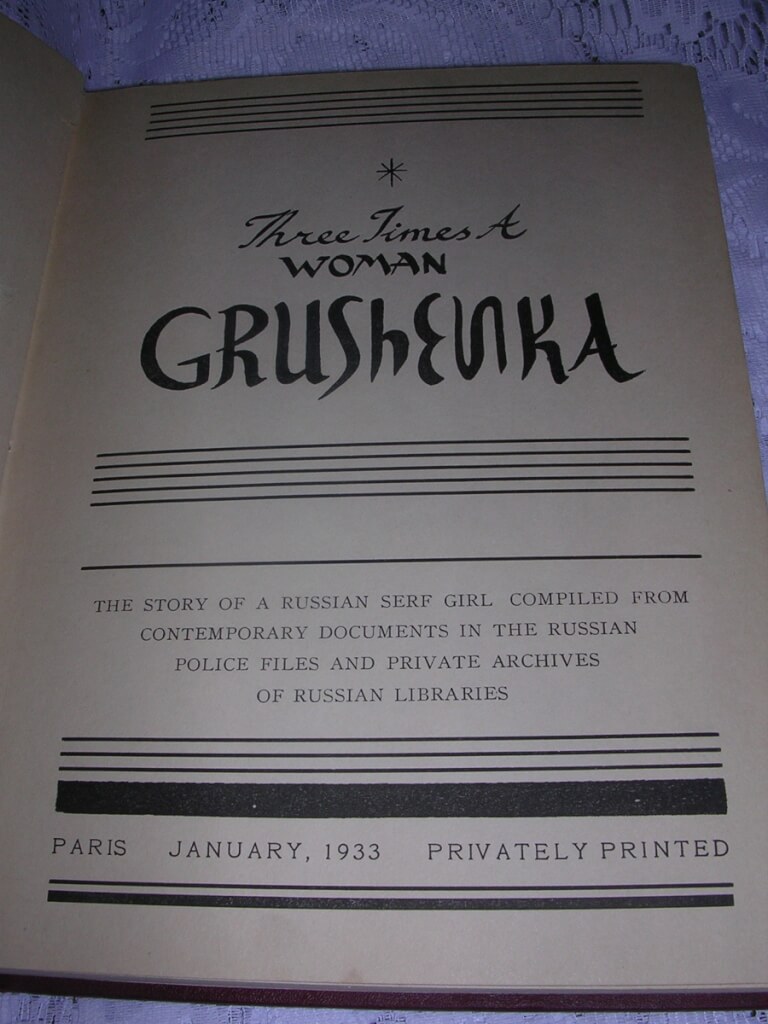 Three Times a Woman, Grushenka, anonymous [possibly Val Lewton?], illus. "a young Russain residing in Paris, who unfortunately must remain annonymous" (Privately Printed, London [New York], 1933 [probably a reprint as it does not have illustrations of the original]) 9 7/8" X 6 7/8", 252pp, hardbound no DJ, red boards with gilt title on spine, good condition, minor wear and bumps to cover, binding tight, bookplate of Erwin A. Weiss, D.D.S. Title page reads: "The Story of a Russian Serf Girl Compiled from Contemporary Documents in the Russian Police Files and Private Archives of Russian Libraries" Originally published at New York in 1933 with a false Paris imprint. Val Lewton, the supposed author, was a well known film producer, responsible for a series of good low-budget horror movies in the 1940's by such directors as Robert Wise, Mark Robson and Jacques Tourneur. The book purports to be a flaggelation story written by a Russian living in Paris and then translated to english. The story takes place c. 1728, "shortly after the death of Peter the Great". The main character is Grushenka Pavlovsk.
Three Times a Woman, Grushenka, anonymous [possibly Val Lewton?], illus. "a young Russain residing in Paris, who unfortunately must remain annonymous" (Privately Printed, London [New York], 1933 [probably a reprint as it does not have illustrations of the original]) 9 7/8" X 6 7/8", 252pp, hardbound no DJ, red boards with gilt title on spine, good condition, minor wear and bumps to cover, binding tight, bookplate of Erwin A. Weiss, D.D.S. Title page reads: "The Story of a Russian Serf Girl Compiled from Contemporary Documents in the Russian Police Files and Private Archives of Russian Libraries" Originally published at New York in 1933 with a false Paris imprint. Val Lewton, the supposed author, was a well known film producer, responsible for a series of good low-budget horror movies in the 1940's by such directors as Robert Wise, Mark Robson and Jacques Tourneur. The book purports to be a flaggelation story written by a Russian living in Paris and then translated to english. The story takes place c. 1728, "shortly after the death of Peter the Great". The main character is Grushenka Pavlovsk. -
Out of stock
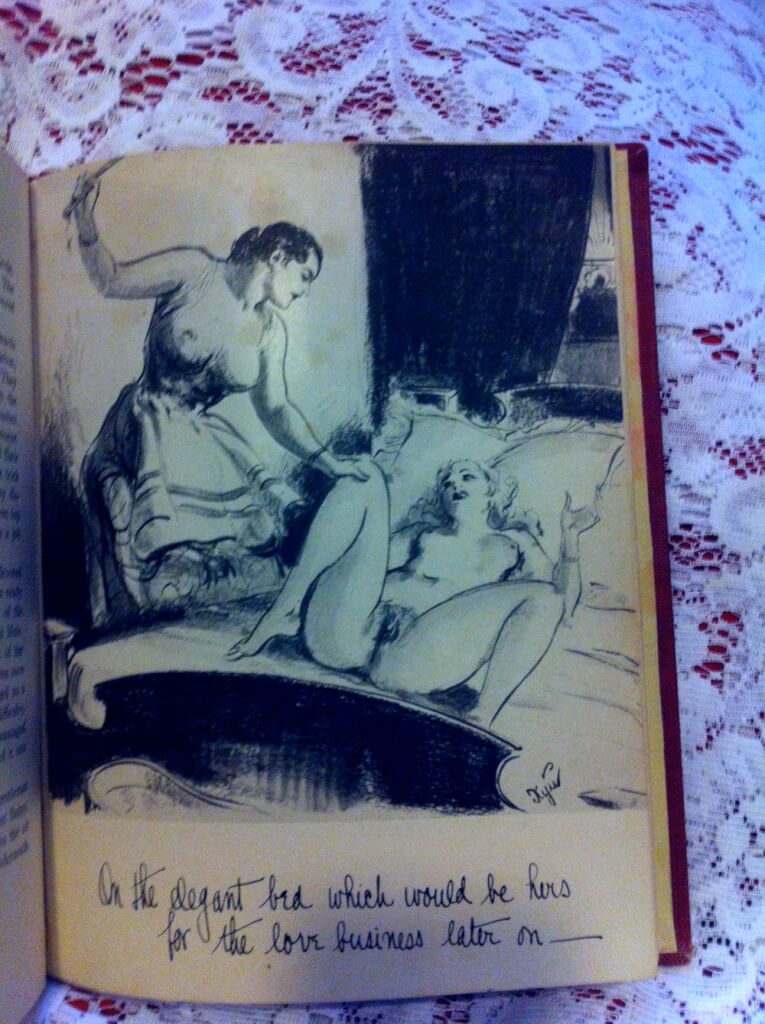
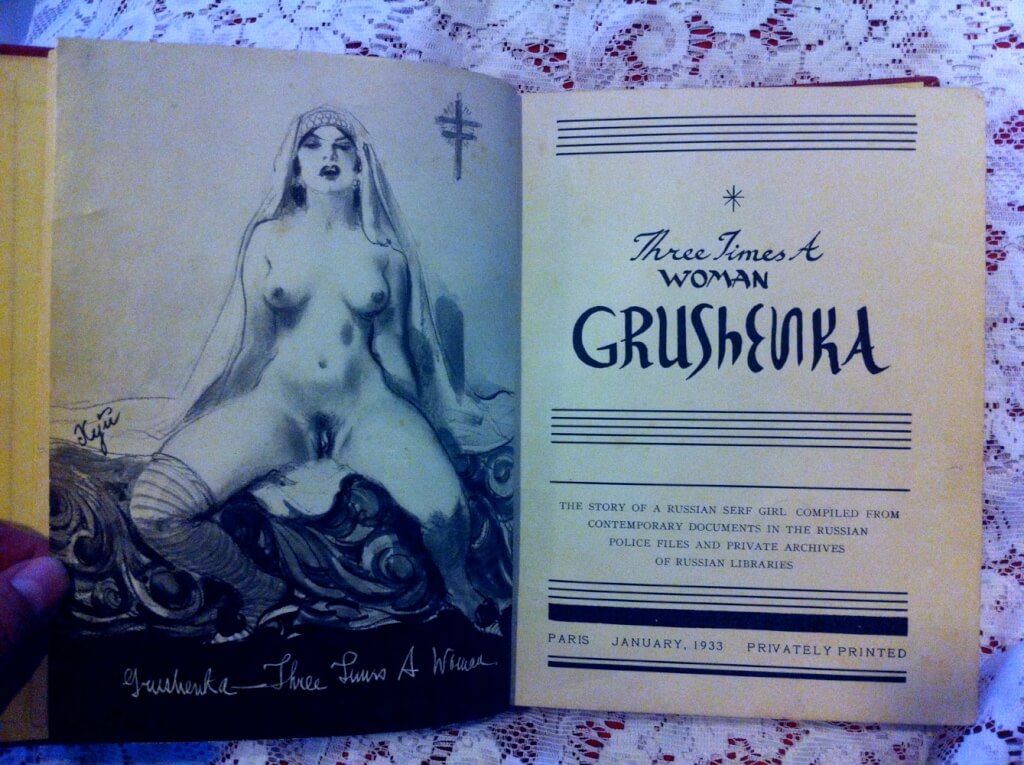 Three Times a Woman, Grushenka, anonymous [possibly Val Lewton?], illus. "a young Russian residing in Paris, who unfortunately must remain anonymous" (Privately Printed, London [New York], 1933) 9" X 7", 252pp, hardbound no DJ, red boards with gilt title on spine, good condition, minor wear and bumping, anonymous bookplate with the profile of a man made from many copulating couples. Title page reads: "The Story of a Russian Serf Girl Compiled from Contemporary Documents in the Russian Police Files and Private Archives of Russian Libraries" Originally published at New York in 1933 with a false Paris imprint. Val Lewton, the supposed author, was a well known film producer, responsible for a series of good low-budget horror movies in the 1940's by such directors as Robert Wise, Mark Robson and Jacques Tourneur. The book purports to be a flaggelation story written by a Russian living in Paris and then translated to english. The story takes place c. 1728, "shortly after the death of Peter the Great". The main character is Grushenka Pavlovsk. This edition is complete with very explicit illustrations.
Three Times a Woman, Grushenka, anonymous [possibly Val Lewton?], illus. "a young Russian residing in Paris, who unfortunately must remain anonymous" (Privately Printed, London [New York], 1933) 9" X 7", 252pp, hardbound no DJ, red boards with gilt title on spine, good condition, minor wear and bumping, anonymous bookplate with the profile of a man made from many copulating couples. Title page reads: "The Story of a Russian Serf Girl Compiled from Contemporary Documents in the Russian Police Files and Private Archives of Russian Libraries" Originally published at New York in 1933 with a false Paris imprint. Val Lewton, the supposed author, was a well known film producer, responsible for a series of good low-budget horror movies in the 1940's by such directors as Robert Wise, Mark Robson and Jacques Tourneur. The book purports to be a flaggelation story written by a Russian living in Paris and then translated to english. The story takes place c. 1728, "shortly after the death of Peter the Great". The main character is Grushenka Pavlovsk. This edition is complete with very explicit illustrations. -
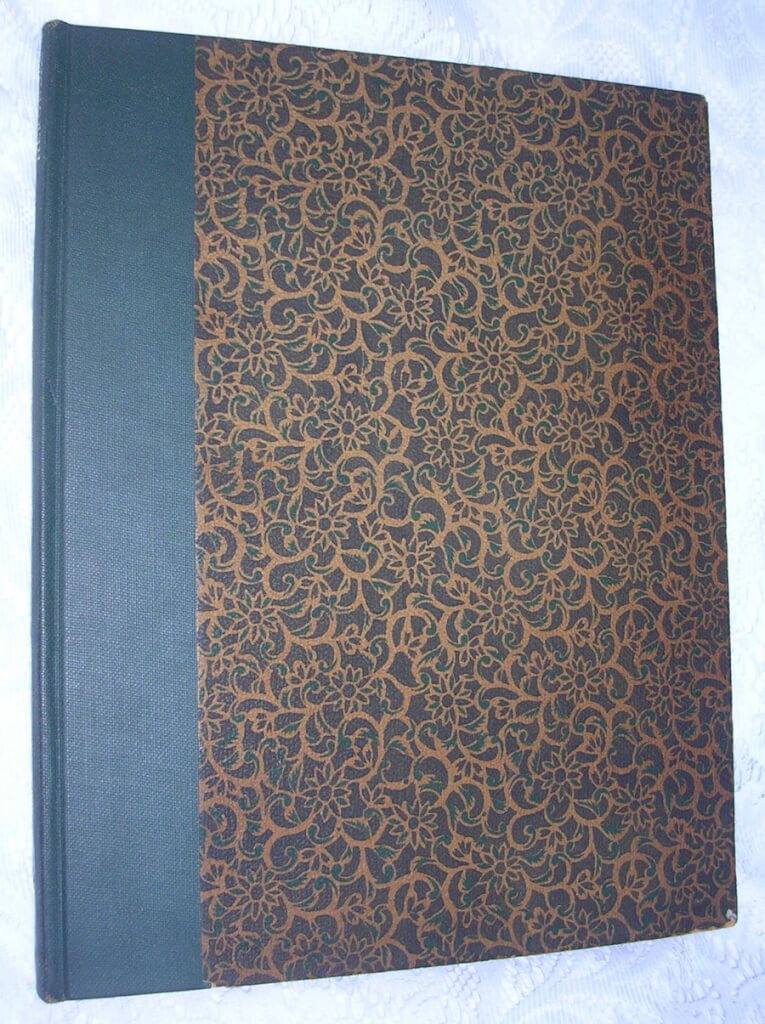
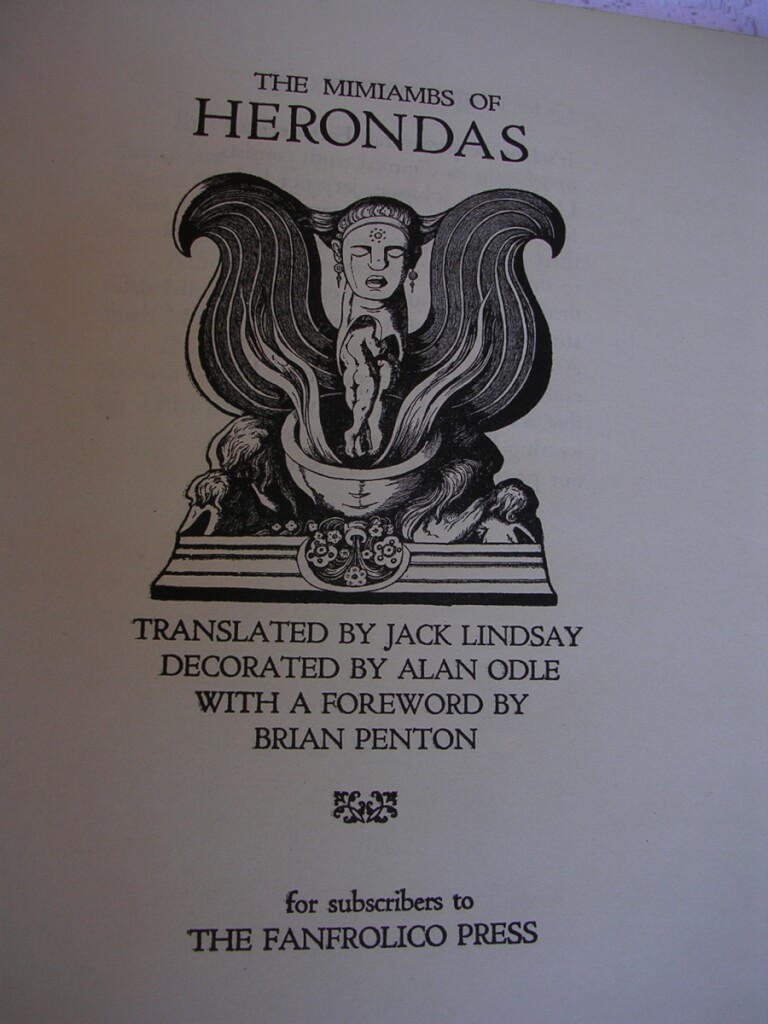 The Mimiambs of Herondas, Herodas, Translated by Jack Lindsay, Decorated by Alan Odle, with a Foreword by Brian Penton. (The Fanfrolico Press, London, nd [c. 1929], #106/375 [first edition, and first Fanfrolico to be printed in London]) 11 7/8" X 9 3/8", unpaginated 72pp, hardbound no DJ, original buckram-backed decorated Japanese paper boards with plain green cloth spine and gilt lettering, top edge gilt, other edges deckle, very good condition minor wear to bottom of boards, Cloister types on Van Gelder Antique handmade paper Herodas was a Greek poet and the author of short humorous dramatic scenes in verse, written under the Alexandrian empire in the 3rd century BC. Mimes were scenes in popular life in South Italy and Sicily, written in the language of the people, vigorous with racy proverbs such as we get in other reflections of that region. The Mimes of Herodas have been known to us only since the discovery and publication of the "Kenyon", M. S. Buck, by the British Museum in 1891 (from a parchment containing 7 legible mimes half of the 8th and a fragment of the 9th). This was Fanfrolico's first London book. It was published "for subscribers to The Franfrolico Press". This new translation of Mimiambs of Herondas was translated by Jack Lindsay and beautifully illustrated by Alan Odle whose grotesque and subversive style was a precursor of surrealism. This is a beautiful printed book in great condition and quite rare. Fanfrolico Press, Australia’s first ‘private press’ in the arts-and-craft tradition, was founded by Jack Lindsay, P. R. Stephensen and John Kirtley, originally in North Sydney in 1923. The press specialized in printings artful, limited editions of classics and forgotten works that were suited to the extravagant style of artist like his father, artist, sculptor and author Norman Lindsay who illustrated many of their books. Fanfrolico was scornful of modernism and with its florid style determinedly backward-looking. They did surprisingly well, despite the lack of business expertise of their young, ambitious "bohemian" owners, eking out a living despite the risky move to London in 1926 and upheavals in ownership that saw the departure in 1927 of Kirtley, and then Stephenson in 1929. Sometime in 1930 they published their last book.
The Mimiambs of Herondas, Herodas, Translated by Jack Lindsay, Decorated by Alan Odle, with a Foreword by Brian Penton. (The Fanfrolico Press, London, nd [c. 1929], #106/375 [first edition, and first Fanfrolico to be printed in London]) 11 7/8" X 9 3/8", unpaginated 72pp, hardbound no DJ, original buckram-backed decorated Japanese paper boards with plain green cloth spine and gilt lettering, top edge gilt, other edges deckle, very good condition minor wear to bottom of boards, Cloister types on Van Gelder Antique handmade paper Herodas was a Greek poet and the author of short humorous dramatic scenes in verse, written under the Alexandrian empire in the 3rd century BC. Mimes were scenes in popular life in South Italy and Sicily, written in the language of the people, vigorous with racy proverbs such as we get in other reflections of that region. The Mimes of Herodas have been known to us only since the discovery and publication of the "Kenyon", M. S. Buck, by the British Museum in 1891 (from a parchment containing 7 legible mimes half of the 8th and a fragment of the 9th). This was Fanfrolico's first London book. It was published "for subscribers to The Franfrolico Press". This new translation of Mimiambs of Herondas was translated by Jack Lindsay and beautifully illustrated by Alan Odle whose grotesque and subversive style was a precursor of surrealism. This is a beautiful printed book in great condition and quite rare. Fanfrolico Press, Australia’s first ‘private press’ in the arts-and-craft tradition, was founded by Jack Lindsay, P. R. Stephensen and John Kirtley, originally in North Sydney in 1923. The press specialized in printings artful, limited editions of classics and forgotten works that were suited to the extravagant style of artist like his father, artist, sculptor and author Norman Lindsay who illustrated many of their books. Fanfrolico was scornful of modernism and with its florid style determinedly backward-looking. They did surprisingly well, despite the lack of business expertise of their young, ambitious "bohemian" owners, eking out a living despite the risky move to London in 1926 and upheavals in ownership that saw the departure in 1927 of Kirtley, and then Stephenson in 1929. Sometime in 1930 they published their last book. -

 Mémoires de Fanny Hill, Femme de Plaisir, John Cleland (Bibliothèque Des Curieux, Paris, 1914) 9" X 5 5/8", 281pp, soft bound, deckle edges, many pages uncut/unread, "decorated with six compositions from the series of engravings by William Hogarth: La Destin_e d'une Courtisane", fair condition, good considering it's age, pages yellow and small rips near spine Written while the author was in debtor's prison in London and first published in 1749, Fanny Hill is considered the first original English prose pornography, and the first pornography to use the form of the novel. One of the most prosecuted and banned books in history, it has become a synonym for obscenity. This book appeared as a part of a series "Les Maitres de l'amour" (The Masters of Love). "With documents about life in London in the eighteenth century, including Life after the gallant Serails of London, Introduction and bibliography by Guillaume Apollinaire"
Mémoires de Fanny Hill, Femme de Plaisir, John Cleland (Bibliothèque Des Curieux, Paris, 1914) 9" X 5 5/8", 281pp, soft bound, deckle edges, many pages uncut/unread, "decorated with six compositions from the series of engravings by William Hogarth: La Destin_e d'une Courtisane", fair condition, good considering it's age, pages yellow and small rips near spine Written while the author was in debtor's prison in London and first published in 1749, Fanny Hill is considered the first original English prose pornography, and the first pornography to use the form of the novel. One of the most prosecuted and banned books in history, it has become a synonym for obscenity. This book appeared as a part of a series "Les Maitres de l'amour" (The Masters of Love). "With documents about life in London in the eighteenth century, including Life after the gallant Serails of London, Introduction and bibliography by Guillaume Apollinaire" -
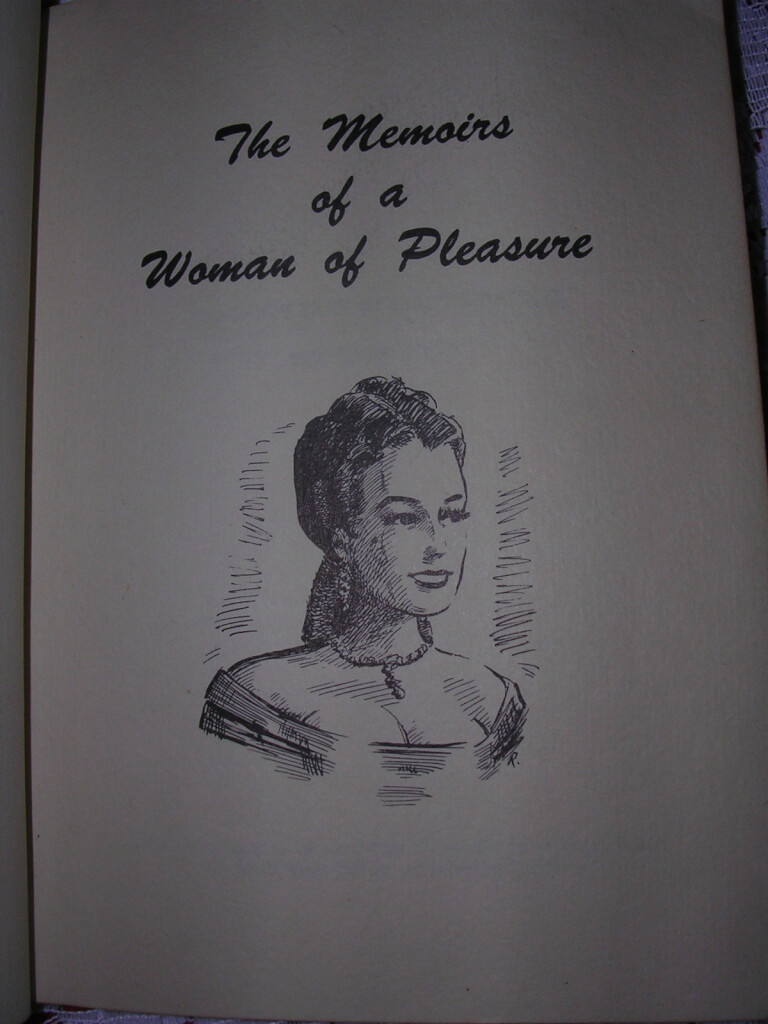
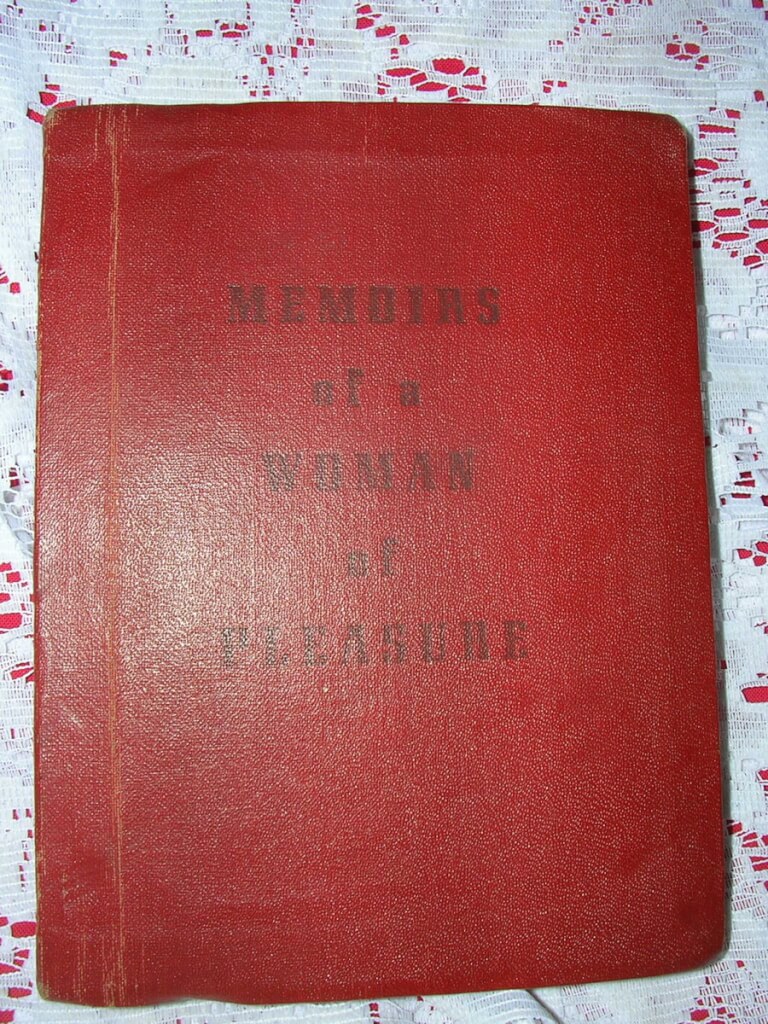 The Memoirs of a Woman of Pleasure, John Cleland (no author given) (Rare Book Co., 1949 "privately printed and a limited edition") 6 1/8" X 4 5/8", unpaginated, red limp cloth binding, illustrations by Ron Hart Written while the author was in debtor's prison in London and first published in 1749, Fanny Hill is considered the first original English prose pornography, and the first pornography to use the form of the novel. One of the most prosecuted and banned books in history, it has become a synonym for obscenity. This copy of the book only slightly resembles the original (they also neglected to name Cleland as the author). I believe this to be a "cleaned-up" version of the story. To the best of my knowledge, all eroticism has been purged. It was published by the Rare Book Company which was the publishing house for the Christian Scientists! I cannot find any mention of this little book anywhere else.
The Memoirs of a Woman of Pleasure, John Cleland (no author given) (Rare Book Co., 1949 "privately printed and a limited edition") 6 1/8" X 4 5/8", unpaginated, red limp cloth binding, illustrations by Ron Hart Written while the author was in debtor's prison in London and first published in 1749, Fanny Hill is considered the first original English prose pornography, and the first pornography to use the form of the novel. One of the most prosecuted and banned books in history, it has become a synonym for obscenity. This copy of the book only slightly resembles the original (they also neglected to name Cleland as the author). I believe this to be a "cleaned-up" version of the story. To the best of my knowledge, all eroticism has been purged. It was published by the Rare Book Company which was the publishing house for the Christian Scientists! I cannot find any mention of this little book anywhere else.
